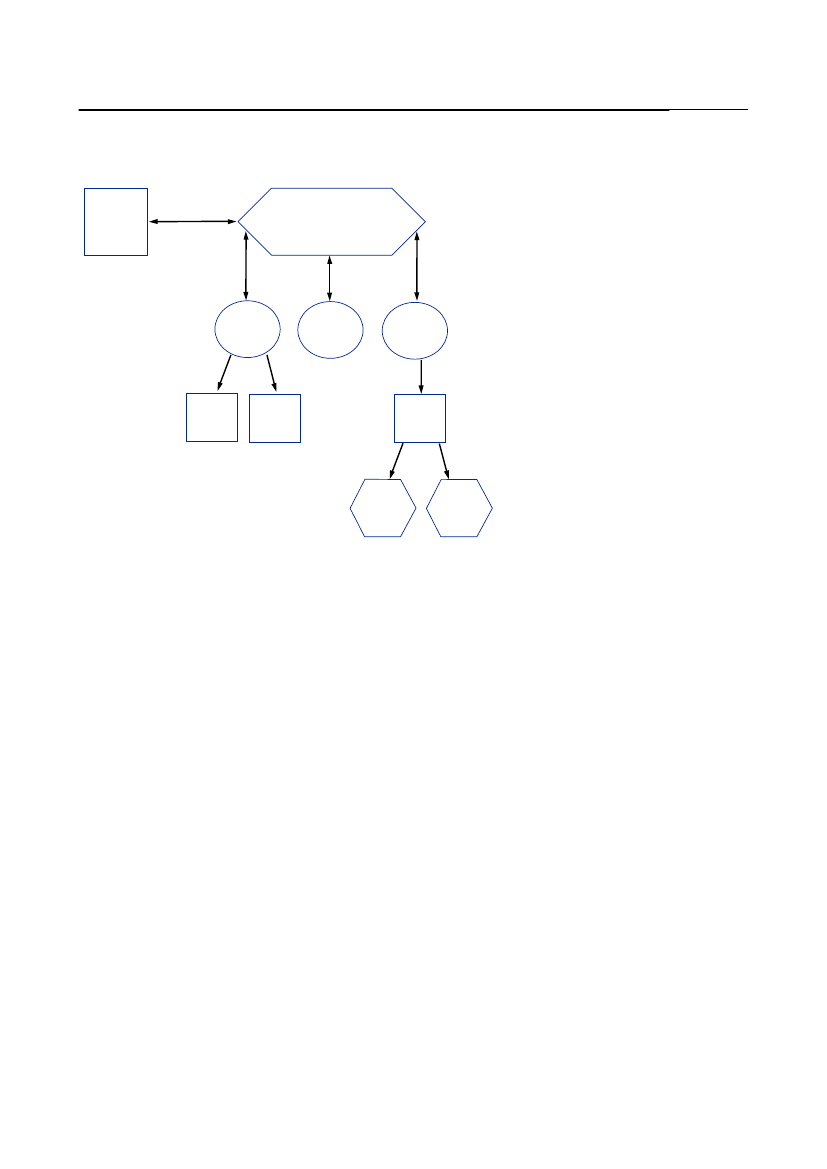Beskæftigelsesudvalget 2012-13
BEU Alm.del
Offentligt
Liability in subcontracting processesin the European construction sector
Wyattville Road, Loughlinstown, Dublin 18, Ireland. - Tel: (+353 1) 204 31 00 - Fax: 282 42 09 / 282 64 56email: [email protected] - website: www.eurofound.europa.eu
Authors:Mijke Houwerzijl and Saskia PetersInstitute:Radboud University, Nijmegen, the NetherlandsResearch managers:Gregorio de Castro, John Hurley and Stavroula DemetriadesProject:Liability in subcontracting
ContentsExecutive summaryIntroduction1. Liability in subcontracting chains2. Detailed review of relevant national laws on joint and several liability3. Practical relevance and effective impact of rules4. ConclusionsReferencesAnnex: National summaries of liability arrangements1471030445052
Executive summaryThe unprecedented rate of economic activity in the European construction industry over the last quarter of a century hasplayed a major role in raising employment levels across most economies of the European Union. This development hasbenefited large and small companies, as well as driven entrepreneurship, with self-employed people making up about25% of the total labour force in the sector. As a result of the construction boom, the industry has witnessed a rapid spreadof the practice of subcontracting, encompassing increasingly long chains of interconnected companies.This scenario has redefined employment relations in the construction sector and, at the same time, reduced the directsocial responsibility of the ‘principal contractor’, as labour has been externalised by the use of subcontractors andemployment agencies.Such changes have raised questions over the impact of subcontracting on employment conditions in the sector, morespecifically in terms of: the legal implications of subcontracting for employers and workers; its impact on employeerights; the increased potential for ‘social dumping’ and a potential avoidance of fiscal responsibilities.Against a backdrop of increased European and national policy attention regarding this highly sensitive issue, Eurofoundset out to conduct a pioneering piece of research by analysing existing national legislation on liability in subcontractingprocesses.
Policy contextThe steadily evolving integration and enlargement of the internal market, together with the free movement of capital,goods, services and workers, has led to a greater movement of labour across countries. This has been particularlynoticeable at the lower ends of the subcontracting chains, where foreign companies and/or posted workers often operate.In response to this outsourcing of tasks, and in an attempt to guarantee decent employment conditions and security forworkers, eight EU Member States have over the years introduced provisions relating to ultimate liability in thesubcontracting chain – that is, Austria, Belgium, Finland, France, Germany, Italy, the Netherlands and Spain. In four ofthese countries – Belgium, Germany, Italy and Spain – liability legislation applies particularly and exclusively to theconstruction sector. In half of the countries, the Sectoral Social Partners have played a significant role in the law makingprocesses.At EU level, the European Commission has emphasised that employment conditions offered to posted workers must bein line with the minimum conditions established by law or negotiated under generally applicable national collectiveagreements. The issue of liability has also been addressed in a recent European Commission Communication on the1posting of workers in the framework of the provision of services (COM(2007) 0304 final) and been the subject ofdiscussion in the context of the debates on modernising labour law and combating undeclared work.
Key findingsOrigins and aims of legislationThe research shows that legislation on liability in subcontracting processes in most of the countries dates back to the1960s (Italy, the Netherlands) or 1970s (Belgium, Finland, France). Legislation was introduced at a later date in Spain(1980), Austria (1990s) and Germany (1999–2000). The regulations were introduced in order to prevent the abuse ofemployees’ rights and the evasion of the rules, as well as to combat undeclared work and illegal or unfair businesscompetition.
1
http://eur-lex.europa.eu/LexUriServ/LexUriServ.do?uri=CELEX:52007DC0304:EN:NOT1
� European Foundation for the Improvement of Living and Working Conditions, 2008
Liability in subcontracting processes in the European construction sector
From this common background emerges the more indirect aim of securing social security schemes and tax payments,along with safeguarding the public interest. Furthermore, in three of the eight Member States – Austria, France and Italy– the rules were developed in a cross-border context, in order to prevent social dumping in the construction sector.Nature of the liabilityThe study differentiates between two main types of liability:joint and several liability – this only applies at one level of the employment relationship, that is, when a subcontractordoes not fulfil its obligations regarding payments, for example, to the Inland Revenue; in such instances, thecontractor, together with the subcontractor, can be held liable by the Inland Revenue for the entire debt of thesubcontractor;chain liability – this applies not only in relation to the contracting party, but also to the whole chain. In this case, theInland Revenue may address all parties in the chain for the entire debt of a subcontractor.Different variations of chain liability arrangements can be found in Finland, Germany, Italy, the Netherlands and Spain.Whereas, a purely contractual liability – restricted to the direct contracting party - is established in the regulations of fivecountries and joint liability in three of them.Coverage of liabilityCoverage of the liability laws contains a material, personal and territorial scope for all of the Member States underconsideration. In relation to the material scope of the liability, three main categories of obligations covered by theliability arrangements can be distinguished: minimum wages, social security contributions and tax on wages. Theresearch found that the liability schemes of all the Member States covered at least two of these categories of obligations.Concerning the personal scope, a differentiation is made between the employer and the workers. In the case of theformer, the scope of the regulations varies greatly between the countries, while for the latter the scope of the liability issimilar across the Member States. Territorially, the main part of the rules examined apply throughout the country, whichin principle covers all parties established in other Member States when providing services in the country concerned.Preventive toolsAll of the eight Member States, except Belgium, were found to have preventive tools in place which seek to diminishthe possibility of liability for the parties concerned. These may be divided into two categories: measures which aim tocheck the general reliability of the subcontracting party and/or temporary work agency; and measures which seek toguarantee the payment of wages, social security contributions and wage tax.SanctionsSanctions for parties who do not abide the liability rules fall under three main categories across the eight Member States:back-payment obligations, fines and/or alternative additional penalties.EnforcementSimilarly, all of the countries under consideration reported facing serious problems regarding the enforcement andapplication of their liability arrangements on foreign subcontractors and/or temporary work agencies. Regarding liabilityfor wages, the main obstacles concerned problems with the language, non-transparent or inaccessible legislativeinformation, difficulties in proving abuses and problems in cross-border judicial proceedings. Concerning liability forsocial security and taxes, the main problem cited was that foreign subcontractors and their foreign workers are most oftencovered by the regulations in their country of origin instead of those of the host country.
2
� European Foundation for the Improvement of Living and Working Conditions, 2008
Liability in subcontracting processes in the European construction sector
Role of social partnersIn all but one of the countries examined, the national authorities play either a monitoring role and/or act as potentialclaimants involved in the liability regimes at stake. The social partner organisations play multiple roles – for example,acting as advisers, representatives and providers of legal aid to individual members, as well as being parties to CollectiveLabour Agreements, or providing assistance with monitoring and compliance tasks alongside the local or regionalauthorities.
ConclusionsThe report underlines the significant differences that exist between the various national liability regulations in place inthe eight Member States under consideration. The varying legal tradition and industrial relations cultures in the countriescovered mean that research results are highly specific to each national situation and that few elements are transferable.Overall, the liability rules were deemed to be effective in achieving the specified objectives. Preventive tools offeringincentives to clients or principal contractors through the limitation of or exemption from liability were largely considereda positive element of successful liability regulations. Likewise, developing simple, accessible and understandable normswas identified as essential in the effective implementation of the regulations and in guaranteeing compliance. Moreover,the regulations should not be altered, amended or modified too frequently to avoid confusion.The involvement of the social partners in the development and implementation of the arrangements has proved to be asalient feature of most of the measures categorised as ‘good practice’. One possible way to diminish abuses at the lowerends of the subcontracting chain might be to further develop corporate or sector-based social responsibility initiatives.These could easily be developed through the normal social partner channels of consultation and negotiation, thus leadingto largely binding agreements.The current study may serve to facilitate the exchange of experiences and good practice among Member States on thesubject of liability in subcontracting processes. At the same time, it may enable social partners and legislators to becomebetter informed in relation to an increasingly important policy debate.
� European Foundation for the Improvement of Living and Working Conditions, 2008
3
IntroductionOver the last 25 years, the European construction sector has seen a rapid spread of the practice of subcontracting, withthree main trends developing. The first trend concerns the concept of the ‘umbrella organisation’ – or ‘managementcontracting’ – where core activities are developed within the company and all other activities are realised throughsubcontracting. The second noticeable trend relates to companies that exclusively organise the sale of building worksand subcontract the whole building process. The third main trend concerns the subcontracting of bulk work, such as thecleaning of a building site (see Hellsten, 2007, p. 36).Furthermore, subcontracting chains in the construction industry are becoming increasingly long due to the structure ofthe construction sector, which is characterised by a considerable number of large companies and a big proportion ofsmall and micro enterprises, with self-employed people making up about 25% of the total workforce (see Cremers,2007). These one-person enterprises reflect the labour market tendencies: on the one hand, skilled workers recognise anopportunity to use their skills and experience as an enterprise rather than an employee; on the other hand, some peoplein the sector are working under questionable circumstances and for pay below that set by collective agreements – asituation that can be considered as ‘bogus’ self-employment. A recent example of the latter was revealed by the Unionof Construction, Allied Trades and Technicians (UCATT) in the United Kingdom (UK), where a subcontracting companyemployed a dozen Lithuanian workers. The workers were paid below the agreed minimum wage for the site, did notreceive payment for overtime and were charged excessive deductions for rent, tools and utility bills (see UCATT2press release, 30 June 2008).According to one researcher (Cremers, 2008):‘Thegrowing use of subcontracting for the labour intensive segments of the execution of construction projects doesnot necessarily lead to a deterioration of the working conditions, but it certainly has created a decrease of the directsocial responsibility of the principal contractor. Labour has been “externalised” by the use of subcontractors andagencies.’Mainly in reaction to this outsourcing of tasks and corresponding employers’ obligations, eight Member States of theEuropean Union have introduced provisions relating to the ultimate liability in the subcontracting chain, which largelyapply to the construction and building industry. Indeed, some of these countries – Belgium, Finland, France, Italy andthe Netherlands – have had legal provisions in place for many years. Other countries – Austria, Germany and Spain –have more recently developed legislation to address this issue. The different laws introduced in these Member Statesreflect the different legal traditions of each country in the field of labour law and social policy and, as a result, introducevery diverse instruments to deal with the situation in each national territory.The steadily evolving integration of the Member States’ economies in the internal market of capital, goods, services andpersons – together with the recent EU enlargements – have also led to the greater movement of workers across countries,with the construction industry being particularly affected by this trend. It is at the lower ends of these subcontractingchains, in particular, that foreign companies and/or posted workers are operating. The European Commission recently3emphasised in itspress releaseof 3 April 2008 the importance of ensuring that the employment conditions offered toposted workers are in line with minimum conditions established by law or negotiated under generally applicablecollective agreements (see for example Cremers, 2007; Cremers and Donders, 2004, pp. 48–51). For instance, in one
23
http://www.ucatt.info/content/view/515/30/2008/06http://europa.eu/rapid/pressReleasesAction.do?reference=IP/08/514&format=HTML&aged=0&language=EN&guiLanguage=en
4
� European Foundation for the Improvement of Living and Working Conditions, 2008
Liability in subcontracting processes in the European construction sector
case covered by the European Foundation for the Improvement of Living and Working Conditions (Eurofound), thePolish company ZRE Katowicz Ireland Construction Ltd had been contracted by a German enterprise to carry outscaffolding work on a large contract which the German company had with the Irish power plant operator, the ElectricitySupply Board (ESB), for the €380 million refurbishment of its plant. When the German company discovered that ZREhad not been complying with Irish employment law, it terminated its contract, forcing ZRE to dismiss 200 of it Polishemployees (Eurofound, 2007, pp. 11–13).In this context, when gaps in the enforcement of national and Community law were becoming increasingly visible,policymakers began to search for effective compliance tools. This also prompted a debate on the chain liability ofprincipal contractors in subcontracting chains. At European level, this debate has been launched by the EuropeanParliament and partly fuelled by the judgement of the European Court of Justice (ECJ) in the case of Wolff and Müller4(C-60/03 ). The liability issue was included by the European Commission (2007) in its Communication on the postingof workers in the framework of the provision of services (COM (2007) 0304 final) and in its questionnaire on Europeanlabour law in the Commission Green Paper ‘Modernising labour law to meet the challenges of the 21st century’5(COM(2006) 708 final).Against the backdrop of the European and national political attention given to this highly sensitive issue, the regulationson liability in subcontracting processes in the construction industry have been explored in the eight Member States understudy – Austria, Belgium, Finland, France, Germany, Italy, the Netherlands and Spain. This research report,commissioned by Eurofound, is based on the material provided by the eight country reports and explains and comparesthe national liability arrangements. In particular, it highlights the similarities and differences between the systems, aswell as the positive components, challenges and problems that they pose for the actors involved in the different MemberStates.
Methodology, aims and limitations of studyThe material gathered for the eight country reports consists of a literature study analysing the regulations on joint andseveral liability in force, along with the case law, policy statements and publications by social partners and policymakers;it also examines the empirical research conducted on the practical relevance and effective impact of the laws, withparticular emphasis on the construction sector where relevant. For the empirical part of the study, the national expertsconducted face-to-face and telephone interviews with the relevant national authorities, social partners and otherprofessional bodies involved. The country reports served as the basis for the present comparative report.The aim of the combined literature study and empirical research was to create a methodological overview of the existinglegislation and the way the laws are working in practice. The analysis sought to pinpoint best practice, shortcomings andcommon denominators in order to facilitate policy debates at national and European level on the liability issue.For a proper interpretation of the present study and its results, it is important to acknowledge both its strengths andlimitations. Since it is the first time that comparative research on the theme of liability in the context of subcontractingprocesses has been undertaken at European level, this study fills a knowledge gap. Thus, given the societal relevance of
45
http://eur-lex.europa.eu/LexUriServ/LexUriServ.do?uri=CELEX:62003J0060:EN:NOThttp://eur-lex.europa.eu/LexUriServ/LexUriServ.do?uri=CELEX:52006DC0708:EN:NOT
� European Foundation for the Improvement of Living and Working Conditions, 2008
5
Liability in subcontracting processes in the European construction sector
the issue addressed, the added value of this study for policymakers and for future research is clear. Furthermore, thetripartite involvement and collaboration of social partners in each country and at European level in the constructionsector, as well as of national government representatives, guarantees that different perspectives on the research themeare incorporated in all of the reports.However, certain limitations may also arise given the uniqueness and political sensitivity of the research theme, on theone hand, and the fact that the research had to be conducted in a relatively short time frame and with a limited budget,on the other hand. In this respect, it is important to note that the comparative and the national reports are predominantlyof an exploratory, descriptive and explanatory nature, and may only serve as an introductory overview in this context. Itshould also be highlighted that the circumstances for research were not the same in each country. Firstly, differencesarose in relation to the ‘maturity’ and quantity of the regulations in force. Secondly, it proved to be more difficult in onecountry, especially Italy, than in others to gain access to the most relevant stakeholders.
Structure of reportThis comparative report is divided into four chapters. Chapter 1 introduces the subject of liability in subcontractingprocesses, giving a brief account of the practice of subcontracting and joint liability, as well as the terminology used inthis highly technical area of law.Chapter 2 provides a detailed overview of the national laws and actors involved in the eight Member States in respectof liability arrangements and largely concerning wages, social security and financial matters. It also identifies the originof the legislation, objectives, coverage, types of tools (preventive measures or sanctions), and common features andelements of the liability arrangements in the eight Member States.Chapter 3 examines the practical implementation of the liability arrangements and the effectiveness of the instrumentsas regards the centre of responsibility for discharging employees’ entitlements and also in combating bogussubcontracting practices. The focus is partly on cross-border subcontracting, as this trend affects the application of thenational instruments on liability in subcontracting chains. Here again, the similarities and differences are identified,while the overall difficulties and best practices encountered in the application of the national liability arrangements areassessed.Finally, Chapter 4 makes some concluding remarks and gives an assessment of the recommendations and options forpolicymakers and social partners, based on the findings reported in Chapters 2 and 3.
6
� European Foundation for the Improvement of Living and Working Conditions, 2008
Liability in subcontracting chainsKey actors and terminology
1
Liability in subcontracting chains is a highly complex matter and encompasses many different actors. In terms of the6parties involved, the subcontracting chain usually features a ‘client’, ‘owner’ and ‘subcontractor’.The subcontracting chain starts with the client, who is defined as: ‘any natural or legal person, public or private, whoorders and/or pays for the works that are the object of a contract’ (the term ‘customer’ is sometimes used but avoided inthis study). Often, the client will also be the ‘owner’. The latter term refers to ‘any natural or legal person, public orprivate, who has for the time being, whether permanently or temporarily, legal title to the building or who is legallyresponsible for its care and maintenance’. In this study, the use of the term ‘client’ is preferred and shall be taken toinclude the term ‘owner’, except where the context would not permit this.The client hires one or more ‘contractors’. A contractor may be defined as ‘any participant who agrees to carry out thephysical execution of the works that are the object of a contract’. If the client only engages the services of one contractorto carry out all the work, then obviously no chain of subcontracting exists. However, the client may also employ theservices of a single contractor which is responsible for the entire building project but which, in turn, outsources part ofthe work to other contractors. In this case, the first contractor is referred to as the ‘principal contractor’ (sometimes alsoreferred to as the ‘main contractor’), while the contractors hired by the principal contractor are known as the‘subcontractors’.In their contractual relationship, the principal contractor and also the intermediary contractor in the chain are deemed the7‘recipient’ party, which orders and pays for the work or services. Meanwhile, the subcontractor – which may also be anintermediary contractor – is considered the ‘provider’, which carries out the work or services requested. Together, theprincipal contractor and all the subcontractors may be labelled as a ‘subcontracting chain’. In relation to ambitiousbuilding projects, the client may also attract several contractors for separate services. In such cases, multiplesubcontracting chains may exist next to each other. It is also possible that the client itself carries out, or could havecarried out, part of the physical execution of the works. In this instance, it may function in a double capacity as both the8client and principal contractor towards (some of) the subcontractors.Apart from outsourcing work to specialised subcontractors – that may carry out the work themselves as self-employedoperators or through their own employees – contractors may also engage external labour to perform some of the workto be done under their supervision. In the last decade, the practice of hiring workers from temporary work agencies hasonly gradually become accepted in the construction industry – although considerable differences still arise between the
6
The definitions of client, owner and contractor are drawn from the 1992 report by GAIPEC (Groupedes AssociationsInterprofessionelles Europeénes de la Construction)on product liability in the construction industry, coordinated by the EuropeanConstruction Industry Federation (Fédérationde l’Industrie Européenne de la Construction,FIEC).The recipient party may also be labelled the ‘order provider’, since this party gives the order to carry out the work. However, inorder to avoid confusion, this term is not used in this study.This is the case in relation to the Dutch liability rules for social security contributions and wage tax. These rules do not apply tothe client, but a specific client is considered equivalent to a principal contractor: the so-called ‘self-constructor’ (see section oncoverage in Chapter 2).
7
8
� European Foundation for the Improvement of Living and Working Conditions, 2008
7
Liability in subcontracting processes in the European construction sector
Member States in this respect. In this study, the parties that only offer the services of their workers to a contractor arereferred to as ‘temporary work agencies’ (the more general term ‘supplier’ may also be used but is avoided in this study).The term ‘agency worker’ is used to refer to those employed by temporary work agencies, while the terms ‘hirer’ or ‘usercompanies’ refer to the parties that hire the agency workers. Temporary work agencies may be functioning at the lowestlevels of the subcontracting chain.A subcontracting chain constitutes a logistical chain, as well as a value chain of an economic and productive nature –‘from conception to completion’. Single specialities or tasks are often ‘externalised’ to small companies or self-employed workers. Over time, the subcontracting chains have tended to take the form of a multiple chain of production– a chain which has both lengthened and broadened. Arising from this practice are construction activities consisting ofdifferent parts of an overall project, executed by various contractors and subcontractors with problems arising in relation9to coordination and efficiency. These activities are carried out simultaneously or in several, subsequent phases. Thechain can be seen as a hierarchical, socioeconomic dependency network or triangle, based on a linked series of contractsand connections.At the top of this triangle, regular and completely legal undertakings exist. In the positive sense, the whole chain wouldbe based on, or could result in, healthy relationships between a main contractor and specialised, preferred subcontractors.However, companies at a lower level in the value chain – with the exception of specialised subcontractors with highlytechnical or other sophisticated activities – are not in a position to act on an equal footing with the main contractor. Animbalance of power in the lower parts of the chain can lead to questionable contracts that define the market transactionsbetween the different levels (paragraph mainly extracted from Cremers, 2008). The problems at the lower ends of thechain have led to the liability arrangements in the Member States examined.In the context of liability arrangements, relevant parties may include the ‘guarantor’, ‘debtor’ or ‘creditor’. A ‘guarantor’is someone who is made liable for paying the debts of the subcontractor if the latter party defaults; in practice, this isusually the principal contractor and/or client. A ‘debtor’ in the context of this study is someone who is in debt regardingthe obligation to pay wages, social security contributions and wage tax; in practice, this mostly concerns thesubcontractor, being the employer of the employees involved. If the debtor does not fulfil the said obligations in respectof the ‘creditor’, it will therefore be indebted to this party – for instance, to the Inland Revenue, social security authoritiesor employees. Thus, the creditor can be a person, company or institution to whom or which the money is owed.
9
This has led to Directives on health and safety at work – that is, Directive 92/57 (temporary and mobile sites) and Directive 92/58(safety signs at work). Moreover, the European Agency for Safety and Health at Work (OSHA) has established the European Forumfor Safety in Construction in order to promote the exchange of experience between players in the sector and, in particular, amongsmall and medium-sized enterprises (SMEs). The Senior Labour Inspectors Committee (SLIC) has also devised awareness-raisinginitiatives in the sector, including European inspection campaigns.
8
� European Foundation for the Improvement of Living and Working Conditions, 2008
Liability in subcontracting processes in the European construction sector
Figure 1:Example of chains of contractors in subcontracting processes
Client/owner
Principalcontractor
Sub 1
Sub 2
Sub 3
Sub1.1
Sub1.2
Sub3.1
Sub3.1
Sub3.1
Source:Adapted from Figure 1 of report by International Labour Organization (ILO, 2008, p. 21)
Joint and several liabilityThe concept of joint and several liability in subcontracting processes can be explained as follows. If, for example, asubcontractor does not fulfil its obligations regarding wages in respect of the Inland Revenue, the contractor togetherwith the subcontractor can be held liable by the Inland Revenue authorities for the entire tax debt of the subcontractor.Therefore, the creditor – in this case the Inland Revenue – can recover the whole indebtedness from either the contractor(guarantor) or the subcontractor (debtor). The contractor is made liable for the total tax debt, regardless of its degree offault or responsibility. The guarantor (contractor) and debtor (subcontractor) are then left to sort out their respectivecontributions between themselves. The logic behind this concept is that it should enable the creditor to address the partywith the best financial resources, which is usually a contractor higher up in the subcontracting chain – often the principalcontractor. Sometimes, the liability is not only of a joint and several nature, but also a ‘chain liability’. This means thatthe joint and several liability applies not only to the contracting party, but also to the whole chain. In the example citedhere, this would mean that the Inland Revenue can address all parties in the chain, which are all jointly and severallyliable, for the entire debt. In other words, it could include not only the contractor but also, for instance, the principalcontractor (see also Chapter 2).
� European Foundation for the Improvement of Living and Working Conditions, 2008
9
2
Detailed review of relevant national lawson joint and several liability
Liability regulationsIn all the Member States under consideration, most of the liability regulations are laid down in legislation. In Finland, itis noteworthy that part of the legislation – more specifically, that concerning the payment of unacceptably low wages toposted workers – is laid down in the country’s Penal Code. In some Member States – Finland, the Netherlands and Spain– part of the relevant rules can be found in the countries’ generally applicable collective agreements. In Italy, along withliability acts and decrees, a tripartite regulation concerning contribution payments in the construction sector exists; thissystem has been established by three parties – the national public institute for pensions, the national public institute forinsurance against labour accidents and a private joint institute for holiday payments in construction.It is also noteworthy that in some of the Member States – Austria, Belgium, Finland and Spain – social partners in theconstruction sector have played a significant role in the lawmaking process and/or the particular legislation is based onsystems developed by the social partners. In the case of Austria, a new bill to this effect is expected to come into forceon 1 January 2009.In four of the Member States – Belgium, Germany, Italy and Spain – liability legislation is in force particularly andexclusively for the construction sector. In Belgium, the Liability Act on subcontracting is applicable to contractorscarrying out ‘certain work’, which mainly covers the construction industry. In Germany, liability provisions for taxobligations are only applicable in the construction sector. In Italy, as mentioned, a tripartite regulation concerningcontribution payments exists in the construction sector. In Spain, more stringent rules exist regarding subcontracting inthe construction industry. Furthermore, in Austria, a bill which was recently put forward and which is set to tackle theproblem of bogus or ‘bubble’ companies will only apply in the construction sector.The liability arrangements of nearly all the Member States investigated include separate regulations for subcontractingand temporary employment through temporary work agencies. In the four Member States Austria, Belgium, France andGermany, these regulations on subcontracting and temporary employment are laid down in separate legislation; in thecase of Germany, a special liability regime for temporary employment regarding social security contributions exists. InFinland, Italy, the Netherlands and Spain, these partly separate regulations are laid down in the same legislative act.In Italy, the temporary work provisions are significantly more rigorous than the provisions regarding subcontracting.Meanwhile, in France, along with separate legislation on bogus subcontracting and temporary employment, a specialliability regulation exists regarding undeclared or illegal work.The liability arrangements of nearly all the Member States under consideration cover the payment of social securitycontributions, wages and tax on wages. Sometimes, the liability is limited to certain percentages or amounts relating tothe contract concerned or to any outstanding debts (see section on ‘Coverage of liability’ in this chapter).
Origins and main objectivesThe legislation on liability in subcontracting processes dates back to the 1960s in the case of Italy and the Netherlands,and to the 1970s in Belgium, Finland and France. The liability legislation was introduced at a later date in Spain (1980),Austria (1990s) and Germany (1999–2002).
10
� European Foundation for the Improvement of Living and Working Conditions, 2008
Liability in subcontracting processes in the European construction sector
A considerable number of similarities were found between the Member States with regard to the background andobjectives of this legislation. Before examining these elements in more detail in each Member State, it is worth givinga short overview of the background and objectives which are common to these eight countries.In all the Member States under consideration, the regulations were introduced mainly against a background of employersevading their obligations and of employees’ rights being abused in subcontracting chains. In Austria, such regulationswere specifically introduced in a cross-border context, while in Germany the rules sought to combat illegal activity inthe building industry in particular. Therefore, the main objectives of the regulations in this context have been to preventabuse of employees’ rights and the evasion of the rules, as well as to combat undeclared work and illegal or unfairbusiness competition. Alongside this common objective is the more indirect aim of securing social security schemes andtax payments – that is, collecting the relevant social and fiscal charges – or, in more general terms, of safeguarding thepublic interest (see for instance the case of Belgium).In the three Member States Austria, France and Italy, the regulations have been developed also or mainly – in the caseof Austria – in a cross-border context. In Austria, they have sought to prevent social dumping in the construction sectorwith foreign companies and workers. In France and Italy, the central aim has been to fight the abuse of posted workersby fraudulent employers in the context of cross-border subcontracting.Despite certain similarities between the countries, the regulations have also arisen against the backdrop of the particularcircumstances prevailing in each Member State. In Austria, the introduction of the Anti-Abuse Act(Antimissbrauchsgesetz) can be attributed to two factors. On the one hand, it is related to the situation in neighbouringGermany in the early 1990s, when a construction boom occurred following the fall of the Berlin Wall: during this period,social dumping with foreign companies and workers emerged as a significant problem in the construction sector; this, inturn, led Austria to establish in 1995 legislation aimed at preventing similar instances of social dumping. At the sametime, Austria’s specific geographical situation can be considered an influential factor: the country had to cope with awide pay gap with the neighbouring countries of the Czech Republic, Hungary, Slovakia and Slovenia. As a result, it wasattractive for companies from these countries – and indeed from all EU Member States – to work in Austria using their10own workers, who might partly be remunerated at the level of their country of origin. This affected the level of wagesand the Austria’s labour market situation.In Belgium, the liability rules were established in the 1970s in response to the appearance of so-called ‘gangmasters’,who declared workers to the social security and tax administration but never paid social security contributions and taxeson wages. This legislation was based on a system developed by the social partners in the construction sector and hasundergone many changes since. Up until 1 January 2008, the liability rules were based on a registration system (whichstill exists): under this system, a contractor could be registered if it met certain reliability requirements. Under the oldrules, principals and contractors that (sub)contracted with foreign partners not registered in Belgium had to withhold15% of the sum payable for work carried out; non-compliance gave rise to a joint and several liability for the tax debtsof such contracting partners. However, this system was abandoned following a ruling by the ECJ of 9 November 2006,which stated that this system violated the freedom to provide cross-border services within the EU as the obligatory nature11of the registration system could have a deterrent effect on foreign companies (Commissionv. Belgium, C-433/04).
10
Note that until 16 December 1999, the EU posted workers directive still had to be implemented in the Member States. Since then,while differences still exist between wages which might indeed constitute a pull factor, in practice the gap should at least havediminished as, according to Article 3, Paragraph 1 of the directive: the foreign service providers will have to comply with a‘nucleus’ of mandatory rules applicable in the host country, among which are mandatory minimum wage levels stipulated inlegislation and/or in generally applicable collective agreements.http://curia.europa.eu/jurisp/cgi-bin/gettext.pl?where=&lang=en&num=79938890C19040433&doc=T&ouvert=T&seance=ARRET11
11
� European Foundation for the Improvement of Living and Working Conditions, 2008
Liability in subcontracting processes in the European construction sector
In Finland in the 1970s, a liability clause was included in the national collective labour agreement (CLA) in the housingconstruction sector. Nowadays, other important national CLAs in the construction industry also include such a clause.Since May 2004, the country’s Penal Code defines the payment of unacceptably low wages to posted workers as acriminal offence. In 2007, the Liability Act entered into force, which is based on the incomes policy agreement for theperiod 2005–2007, concluded by the central social partners. A tripartite governmental committee prepared the details inthe system and the governmental bill reproduced it with only minor modifications.In France, the first legal provisions – introduced in the mid 1970s – regarding liability in subcontracting processes soughtto protect subcontractors rather than their workers if the principal contractor became insolvent. In 1990, a system of jointliability between a principal contractor and its subcontractor was introduced for the payment of wages and social securitycontributions. This legislation must be seen in the context of efforts to combat bogus subcontracting and the abuse ofworkers’ rights. It seeks to stabilise employment and adapt precarious forms of work. In 1979, specific liability rules fortemporary agency workers were introduced to enhance the protection of these workers. Subsequently, in 1992, liabilityprovisions regarding illegal or undeclared work were introduced due to the inadequacy of previous provisions forcombating undeclared work in the context of subcontracting chains. The rules provide an additional guarantee for thepayment of wages, social security contributions and taxes in the case of a fraudulent or disappearing contractor. Mentionshould also be made of the French legislation regarding the cross-border posting of workers, based on EU12Directive 96/71/ECconcerning the posting of workers in the framework of the provision of services; this legislationwas amended in 2005 for the benefit of small and medium-sized enterprises (SMEs).In Germany, the liability regulations were introduced in the period 1999–2001, mainly against the background ofnational and cross-border illegal activity in the construction industry – such as the fraudulent use of (sub)contractingarrangements. The opportunity for such activities increased after the removal of the internal EU frontiers and with theincreasing permeability of its external borders. In 2001, the liability provisions for tax obligations in construction weresubstantially changed. Along with the main objectives, stated above, the liability provision for minimum wages also aimsto protect German SMEs against unfair competition by subcontractors from ‘cheap wage countries’ and to combatunemployment in the German labour market.Since 1960, Italian legislation has provided for a number of regulations regarding liability in subcontracting processes.Since 2004, this legislation has been affected by many profound changes and the liability has been extended. Thebackground for the current legislation was the need to ensure greater protection for workers involved in subcontractingand to safeguard fair competition.In the Netherlands, the legislation has provided for joint and several liability in subcontracting processes since 1960.Initially, this was limited to social security contributions and only applicable to agency workers. However, since 1982,the liability also embraces wage tax and applies to contracting for work. The main objectives of this legislation havebeen to deter unreliable temporary work agencies and subcontractors and the abuse of legal persons, as well as to combatunfair competition. Until 1998, the generally applicable CLA for the construction industry contained a real liabilityprovision. Since 2000, this provision has been a mere social clause. From 2007 onwards, the social clause obliges bothassociated and non-associated employers (main contractors) to contract subcontractors only on the condition that theyapply the provisions of the CLA to their employees. The objective is to ensure greater compliance with correct wagelevels and other labour conditions, as stipulated in the CLA.
12
http://eur-lex.europa.eu/smartapi/cgi/sga_doc?smartapi!celexapi!prod!CELEXnumdoc&lg=EN&numdoc=31996L0071&model=guichett
12
� European Foundation for the Improvement of Living and Working Conditions, 2008
Liability in subcontracting processes in the European construction sector
In Spain, the legislation on joint liability dates back to 1980. The general aims of such legislation are to protect workersand ensure compliance with the regulations by all companies involved in the subcontracting process. A noteworthyobjective is that the law on subcontracting in the construction industry also aims to improve health and safety conditionsand to reduce accidents; at the same time, it seeks to promote the quality and solvency of companies and to introduce amechanism of transparency in work sites by limiting the amount of subcontracting to three links in the chain – althoughit allows for some exceptions to this general rule, for example when specialised work is required, in the case of technicalcomplications, or inforce majeurecircumstances – and by increasing control of this chain.
Coverage of liabilityIn terms of the coverage of the Members States’ liability provisions, this can be further categorised according to: 1) theobligations which fall within the liability, that is, the ‘material scope’; 2) the personal scope; and 3) the territorial scope.Material scopeThe material scope – or employers’ obligations which are covered by the liability provisions – can be distinguishedaccording to three main categories:(minimum) wages;social security contributions;tax on wages.France, Germany, Italy and Spain have liability legislation in place regarding all these obligations. Finland haslegislation that covers social security contributions and wage tax, while wages as well as holiday pay are covered byCLAs. Furthermore, the liability regime of Finland’s Penal Code includes the payment of unacceptably low wages, orthose below the relevant generally binding collective agreement, to posted workers. In the Netherlands, legislation is inplace regarding social security contributions and wage tax, in addition to a generally applicable CLA for the constructionindustry that applies to all material obligations deriving from the CLA, such as wages and paid holidays. In Belgium,the liability regulations on subcontracting cover social security contributions, social fund payments and wage tax, whilethe liability law on agency work covers social security contributions and wages, as well as all work-related benefits. InAustria, the liability rules apply to social security contributions and wages.In some of the Member States, as already mentioned, the liability is limited to certain percentages or amounts relatingto the contract concerned or to any outstanding debts. In Belgium, for instance, regarding social debts, the liabilityextends to 100% of the value of the work. However, the share devoted to social debts is limited to 65% when the liabilityis also established for tax debts, the latter receiving 35%, excluding value-added tax (VAT). In Germany, one of theconditions for joint and several liability regarding social security contributions is that the total value of building servicesis above €500,000. In France, the liability regarding (bogus) subcontracting is limited to contracts for services worthmore than €3,000.13
13
The aforementioned tripartite regulation concerning contribution payments in Italy covers contributions for holiday payments,pensions and health insurance for occupational accidents in the construction sector.
� European Foundation for the Improvement of Living and Working Conditions, 2008
13
Liability in subcontracting processes in the European construction sector
Personal scopeThe personal scope of the liability regulations differs between countries and also frequently between regulations withineach country. Nevertheless, a considerable number of similarities are also evident, especially with regard to theregulations on temporary agency work. In this section, the personal scope of regulations on subcontracting will first beexamined; this will be followed by an analysis of the personal scope of the rules on temporary agency work. For thepurposes of this analysis, the study will distinguish between the employers’ side and the workers’ side. Finally, somespecific conditions for the liability will be mentioned in the last part of this section.SubcontractingEmployers’ sideThe liability provisions may apply to the principal contractor only or to all contractors that subcontract part of the workor services. Furthermore, the liability may also or exclusively apply to the client.Principal contractor onlyIn Austria, liability for wages under the Anti-Abuse Act applies only to the principal contractor, under certaincircumstances. The ‘principal contractor’ is defined as: ‘someone who passes within his business at least a part of aservice that he owes due to a contract to another company (subcontractor)’ (Article 7c, subparagraph 2 of theEmployment Contract Law Adaptation Act (Arbeitsvertragsrechts-Anpassungsgesetz, AVRAG)). In the Netherlands, thesocial clause of the CLA for the construction industry – for wages and other obligations deriving from the CLA – onlyapplies to the principal contractor. In Spain, the liability for wages and social security contributions, as laid down in theWorkers’ Statute, covers the principal contractor, but only if the subcontracted work falls within the scope of the principalcontractor’s ‘own activity’ (see below). The liability also covers the developer if it is acting in the capacity of acontractor. In Finland, the liability for wages as laid down in several CLAs applies only to principal contractors –including user companies – bound by the collective agreement.All contractors that subcontract part of the work/services‘All contractors’ includes the principal contractor as well as (sub)contractors lower down in the chain (the degree ofliability of the contractor, either in terms of liability for the whole chain or only for the direct subcontractor, will bediscussed in the section on ‘Nature of liability’ in this chapter). At least part of the liability provisions in Belgium,Finland, France, Germany, Italy and Spain apply to all contractors. The same is true for the liability legislation in theNetherlands, as laid down in the country’s Wages and Salaries Tax and Social Security Contributions Act (Wetkoppeling14met afwijkingsmogelijkheid,WKA).In Belgium, the liability on wages and social security contributions under the country’s Liability Act applies to allcontractors carrying out certain work; this work mainly covers the construction sector. In Finland, the liability provisionsof the Liability Act apply to contractors in whose Finnish premises the subcontractor’s workers perform works that relateto the contractor’s normal operations. In the building industry, the scope is broader: the provisions apply to allcontractors contracting out part of the work at a shared workplace. Therefore, in subcontracting a link to the contractor’snormal operations is needed, while in building this link is not a prerequisite for the application of the act, which meansthat all construction activities are covered. However, the liability provisions do not apply if the value of compensationis less than €7,500. Finally, the provisions of the Penal Code apply to all (sub)contractors.
14
http://www.eurofound.europa.eu/emire/NETHERLANDS/CONDITIONALINDEXATIONACTWKA-NL.htm
14
� European Foundation for the Improvement of Living and Working Conditions, 2008
Liability in subcontracting processes in the European construction sector
In France, the liability regarding (bogus) subcontracting applies to all (sub)contractors. The liability concerningundeclared or illegal work applies to the client together with the contractors, regarding the direct subcontractingrelationship all along the subcontracting chain. This means that the liability is contractual in nature. In Germany, theliability for tax obligations in the construction sector applies to all contractors that subcontract part of the work orservices; the liability for minimum wages also applies to principal and other contractors in the subcontracting chain, butwith the exception of private individuals, building owners and administrative organs. In Spain, the liability for wagesand social security contributions, as laid down in the Law on subcontracting in the construction industry, covers allcontractors that subcontract part of the job to either companies or self-employed workers. The same is true for theliability regarding wage tax under general tax law, but on condition that the subcontracted work falls within the principaleconomic activity of the contractor (see below).Client15The liability provisions concerning subcontracting also include the client in Finland and France. In Finland – in thecase of building activities – the liability provisions of the Liability Act and the Penal Code also apply to clients actingas builders. In Germany, the liability for tax also applies to the client, except where it is the building owner. In Italy, theliability for wages and social security contributions – in accordance with Legislative Decree No. 276/2003 – applies tothe client with regard to the contractor and any subcontractors. In the Netherlands, the liability rules for social securitycontributions and wage tax under the WKA do not apply to the client. However, a specific type of client is consideredequivalent to a principal contractor: the so-called ‘self-constructor’ (eigen-bouwer). A characteristic feature of the ‘self-constructor’ is that the realisation of the subcontracted work belongs to its ordinary course of business, so that it couldhave carried out the work itself. A ‘self-constructor’ is, for instance, a manufacturer that subcontracts a part of themanufacturing process to another company. In this case, the manufacturer is considered to be both the client and theprincipal contractor.Workers’ sideIn general, the liability regulations of the eight Member States under consideration cover all workers employed by thesubcontractor; this includes ‘flexible’ workers, such as those employed on fixed-term contracts or part-time workers.Therefore, freelance workers and other workers who do not have an employment contract with the subcontractor are notcovered. Moreover, in Austria, employees in public services, that is, those who have a contract with the government, areexcluded from the scope of the Anti-Abuse Act.Temporary employmentEmployers’ sideIn all eight Member States, the liability regulations concerning temporary employment are applicable to the usercompany and the temporary work agency. The user company – which hires workers from the temporary work agency –is liable if the agency does not comply with certain obligations. In Finland, however, the Liability Act only applies touser companies if the duration of temporary work exceeds a total of 10 days.Workers’ sideIn seven of the Member States, the liability regulations concerning temporary employment cover all the workersemployed by the temporary work agency. Only in Belgium is the scope of these regulations less broad: the Law on
15
See Chapter 1 for the distinction between a client and a (principal) contractor. A client does not physically execute any part of thework which is the object of the contract.
� European Foundation for the Improvement of Living and Working Conditions, 2008
15
Liability in subcontracting processes in the European construction sector
agency work covers all agency workers, except posted workers from abroad. In Austria, on the other hand, the scope isbroader than the general scope: the Law on agency work also covers ‘workers’ who are similar to employees and‘workers’ who are not gainfully employed but economically dependent (arbeitnehmerähnlich).Specific conditionsIn some of the Member States’ legislation, the extent of the liability depends on the place where the work is carried outor the nature of the subcontracted work. In France, for example, the coverage of the liability provisions regardingsubcontracting may be extended or limited, depending on whether the work is performed at the workplace or site of theprincipal contractor or client. In Spain, the liability on wages and social security contributions under the Workers’Statute, along with the liability on wage tax under general tax law, only apply if the subcontracted work falls within thescope of the ‘core business’ activities of the contractor. In Finland, the Liability Act applies to any temporary agencywork, whereas in subcontracting a link to the contractor’s normal operations is needed. However, such a link is notrequired in the case of building works; therefore, all (subcontracted) construction activities are covered, unless subjectto specific derogations.With regard to temporary employment, the German legislation is noteworthy. In this country, a liability regime for theuser company exists regarding social security contributions. However, in the building industry, the supply of agencyworkers is only allowed by temporary work agencies that are subject to the same generally applicable frameworkagreements and collective agreements on the social fund scheme as the hiring party for at least three years. For temporary16work agencies from other Member States of the European Economic Area (EEA ), it is sufficient if they predominantlyperform activities that are covered by the scope of this framework for at least three years. Thus, in the building industry,temporary employment business is largely restricted to the so-called ‘colleague assistance’ (Kollegenhilfe) form.Territorial scopeIn all of the eight Member States under study, the liability regulations on subcontracting and temporary agency workapply throughout the country. In principle, this means that the regulations also cover contractors and temporary workagencies established in other Member States when providing services in the country concerned. However, the liabilityrules only come into effect if the cross-border subcontractor has obligations concerning wages, social fund payments,social security contributions and wage tax towards or on behalf of its posted workers in the Member State where it istemporarily carrying out its work in the framework of the provision of services. Whether this is the case dependsprimarily on the European and/or bilateral ‘conflict of law’ rules concerning the following:labour law –Rome Convention 1980and Directive 96/71/EC;social security law –Regulation (EEC) No. 1408/71on the application of social security schemes to employedpersons and their families moving within the Community and/or, in the case of third country nationals, internationalbilateral agreements;tax law – bilateral treaties mainly based on the Organisation for Economic Co-operation and Development (OECD)19model tax convention.1817
16171819
http://ec.europa.eu/external_relations/eea/http://www.rome-convention.org/instruments/i_conv_orig_en.htmhttp://eur-lex.europa.eu/LexUriServ/LexUriServ.do?uri=CELEX:31971R1408:EN:HTMLThe OECD model tax convention serves as a model used by countries when negotiating bilateral tax agreements. These agreementsare entered into by countries to clarify the situation when a taxpayer might find themselves subject to taxation in more than onecountry. The first OECD model tax convention was launched in 1963 and is regularly updated, most recently in 2005 (see OECD,2004).
16
� European Foundation for the Improvement of Living and Working Conditions, 2008
Liability in subcontracting processes in the European construction sector
According to Article 3, Paragraph 1 of the EU posted workers directive, such workers are entitled to minimum wagelevels in the host country, as laid down by national law and/or generally applicable CLAs, provided that these providefor more favourable wages than those owed on the basis of their employment contract. With regard to social securitycontributions, posted workers will generally be covered by the benefit schemes in their country of origin for the first yearand, with the consent of the host country, also for the second year of posting. In terms of wage tax, depending on thespecific bilateral agreement at stake, it may depend on the length and nature (whether or not as an agency worker) of theposting, whether the tax law of the host country applies from day one or only when the duration of the posting exceeds183 days.In certain Member States, some specific rules and exceptions apply in the case of cross-border contracting with theinvolvement of workers. In Austria, the Anti-Abuse Act has separate liability provisions for, on the one hand, EUcompanies, including Austrian companies; these provisions are applicable to domestic and cross-border postedemployees within the EU. On the other hand, the Act also encompasses liability provisions that exclusively apply to non-EU companies; these provisions are applicable to cross-border posted employees from outside the EU.In France, the liability regarding temporary agency work also applies to foreign agencies when active in France.However, these foreign agencies may be exonerated from certain obligations if they have already complied withformalities of the same or of an equivalent effect in their country of origin.In Germany, the Law on the posting of workers (concerning minimum wages and leave fund contributions) provides forthe following: if foreign posted workers are not taxed in Germany, the provider – subcontractor or temporary workagency – may apply for an exemption certificate. If the provider does not apply for an exemption certificate and therecipient – principal contractor or user company – withholds the tax on compensation for construction work, the providercan apply for a tax refund.In Italy, all liability regulations also cover foreign contractors and agencies when active in Italy. Furthermore, they applyto activities abroad pursuant to Italian jurisdiction. In the case of cross-border contracting, foreign Inland Revenue andsocial security authorities can also demand payment by Italian clients of contributions and taxes owed in relation tosubcontracted work or services supplied in Italy by staff who have retained the right to pay taxes and contributions inthe country of origin. The same applies to the payment of taxes and contributions relating to subcontracted work andservices supplied abroad, when the posting abroad cannot be considered temporary or no bilateral agreements existbetween the foreign country and Italy.In the Netherlands, the liability legislation on social security contributions and wage tax may also apply when the workis carried out abroad by Dutch subcontractors.
Nature of liabilityJoint and several liabilityThe concept of joint and several liability in subcontracting processes has already been explained in Chapter 1.The twin concepts ‘joint and several’ are defined in Italian legislation (Article 1292 of the Civil Code) as follows: ‘Anobligation is considered joint and several when each of a number of debtors involved in a single operation can be forcedto comply on behalf of all the others, and the compliance by one of the debtors frees the others from their obligation.’In Italy, according to Legislative Decree No. 223/2006, the contractor is – in relation to the subcontractor – ‘jointly andseverally’ liable for wage tax and social security contributions relative to the employees of the subcontractor.
� European Foundation for the Improvement of Living and Working Conditions, 2008
17
Liability in subcontracting processes in the European construction sector
According to the regulations of several Member States, the liability is not only of a joint and several nature, but is alsoa chain liability. This means that the joint and several liability applies to the whole chain, instead of only the directcontracting party.Chain liability (including joint and several liability)Various types of chain liability, as described here, were found in the liability arrangements of Finland, Germany, Italy,the Netherlands and Spain.In Finland, according to the Penal Code, the payment of unacceptably low wages to (posted) workers is a criminaloffence, which may lead to confiscation by the state of the illegal benefit gained by paying the illegally low wages. Theconfiscation claim may also be directed against a (principal) contractor or user company. Confiscation cannot be orderedif the (posted) workers concerned present their wage claims. This represents a kind of chain liability for the part of theconfiscation possibility, but not with regard to real wage claims.In Germany, the liability provision for minimum wages contains an unconditional chain liability, that is, joint and severalliability; accordingly, the principal contractor, client, intermediary contractor or user company are jointly and severallyliable. In addition, regarding social security contributions, a joint and several liability exists – under certain conditions;the conditions are, for instance, that the transaction must aim to circumvent the law and that the total value of thebuilding services amount to €500,000 or over. If such conditions are fulfilled, the health insurers as collecting agencieshave the right to choose to claim on the client, principal contractor, intermediary contractor or user company (thebuilding owner is excluded); these parties are all jointly and severally liable.In Italy, the liability for social security contributions, wage tax and wages (Legislative Decree No. 276/2003) is a chainliability. The client or contractor is liable with regard to the contractor and any subcontractor(s). The subcontractor’semployees can bring a direct action against the contractor and the client. However, concerning wage tax, the liability ofthe client will be abolished in the near future under Legislative Decree No. 97/2008 of 3 June 2008.In the Netherlands, the liability legislation under the WKA stipulates a joint and several liability for the user company,as well as for the (principal) contractor, for the whole chain of temporary work agencies and/or subcontractors thatfollow in line and that are working on the same project at the building site.The Spanish Workers’ Statute contains a joint and several chain liability with regard to the principal contractor only forsocial security contributions and wages; however, this liability only applies if the subcontracted work falls within thescope of the principal’s ‘own activity’. Principal contractors in the construction sector are, on the other hand, subject toan unconditional chain liability – that is, joint and several liability – regarding social security contributions and wagesunder the Law on subcontracting in the construction industry.Contractual liability‘Contractual liability’ means that the liability is restricted to the direct contracting party and therefore to one level ofsubcontracting. As a result, no chain liability arises. For instance, the principal contractor is liable only for its directcontractor, and that contractor only for its direct subcontractor in turn. This kind of liability can be found in Austria(Anti-Abuse Act); Finland (Liability Act), France (liability regarding (bogus) subcontracting and liability regardingillegal or undeclared work) and Germany (liability provisions for tax obligations in construction). In Austria, this liabilityis restricted to the highest level in the subcontracting chain – that is, to the principal contractor, according to the Anti-Abuse Act (Article 7c.3 of AVRAG). Finally, the Belgian Liability Act of 2008 contains mainly a contractual liability;nevertheless, under certain circumstances, this liability may acquire a joint nature.
18
� European Foundation for the Improvement of Living and Working Conditions, 2008
Liability in subcontracting processes in the European construction sector
Joint liabilityIn Belgium, the liability acquires a joint nature if the contracting party of the contractor with social security and tax debtshas failed to meet its obligations after being formally pressed for payment by the administration. Only if these conditionsare fulfilled will the next level in the chain be addressed. In France, the user company is jointly liable if the temporarywork agency defaults and its insurance proves insufficient to pay the wages and social security contributions. Theliability of the user company is proportional to the duration of the temporary employment contract. Regardingundeclared or illegal work, under certain conditions, a joint liability of the client together with the contractors arisesregarding the direct subcontracting relationship. Finally, in Spain, the temporary employment provisions of the Workers’Statute provide for a subsidiary liability of the user company, which becomes a joint liability if certain provisions havebeen infringed.Special types of liabilityAccording to the Belgian Law on agency work, a liability arises if the employment agency transfers part of its authorityto the user company. In this case, the employment contract of the agency worker with the agency will automatically betransformed into an open-ended contract with the user company.In Finland, the CLA in the housing construction sector includes a clause which stipulates that the principal contractor isliable for the subcontractor’s or temporary work agency’s unpaid wages and holiday pay, under certain conditions. Thisobligation is, however, ultimately a moral obligation.The CLA for the construction sector in the Netherlands does not contain a real liability, but only a social clause. Thisplaces an obligation on the principal contractor to monitor the compliance of the CLA’s provisions in all individualemployment contracts covered by the agreement; the principal contractor is obliged to agree on this in the subcontractingarrangement.Finally, it should be mentioned that, in Austria, several types of liability can be found in one regulation. The Anti-AbuseAct contains three types of liability: joint and several liability (Article 7a, subparagraph 2); ‘normal’ liability, whichmeans that the precondition for the liability is that the principal debtor received a warning but has still failed to pay(Article 7c, subparagraph 2); and ‘secondary’ liability, which means that the contractor is only liable if the subcontractorcannot pay the debt (Article 7c, subparagraph 3). Furthermore, the Law on agency work contains a normal liability(Article 14, subparagraph 1) and a secondary liability (Article 14, subparagraph 2). The secondary liability exists if theuser company can prove that it has fulfilled its financial obligations deriving from the contract with the temporary workagency.
Preventive measures used in framework of liability arrangementAs part of, or in connection with, the liability arrangements in the different Member States, several tools have beendeveloped to either prevent the possibility for liability among the relevant parties or to sanction the parties which did notfollow the rules. An overview of the different sanctions will be provided in the next section of this chapter.In terms of the preventive tools in place, these may be divided into two main categories:measures seeking to check the general reliability of the subcontracting party;measures aiming to guarantee the payment of wages, social security contributions and wage tax.
� European Foundation for the Improvement of Living and Working Conditions, 2008
19
Liability in subcontracting processes in the European construction sector
With regard to these preventive tools, three possible scenarios may occur in the eight Member States underconsideration: no preventive tools may exist; the preventive tools may be optional; or they may be obligatory preventivetools. Moreover, when such measures are established, they may either be embedded in a self-regulatory framework orin a legal framework.Before describing these measures, it is interesting to observe that, in Spain, a comparatively different preventive tool wasintroduced in 2006. In this particular country, the monitoring and surveillance obligations of Law 32/2006 aim to restrictthe length of the subcontracting chain, with no more than three vertical levels allowed in the chain; some exceptions tothis limitation are, nevertheless, foreseen in situations where specialised work is required, where technical complicationsarise or inforce majeurecircumstances. In addition, the certification of adequate training and organisation in the area ofoccupational hazard prevention are prescribed by the measures. The certificates issued by the relevant Register ofAccredited Companies for this purpose are of special importance.Checking reliability of subcontractor or temporary work agencyIn five of the eight Member States – Austria, Belgium, Germany, Italy and the Netherlands – no general obligation existsfor the client or the principal contractor to check the reliability of the subcontractor or temporary work agency. However,in practice, not checking can result in a higher chance of liability and/or sometimes failure to do so is sanctioned with amore strict liability regime. Private parties may therefore choose to voluntarily include a clause on reliability checks intheir contract as a safeguard against liability. The Italian national report, in particular, refers to regular use of thispossibility. Prior to entering into a contracting or subcontracting agreement with a contractor, the client must first verifythat the contractor and any subcontractor(s) it chooses have their affairs in order regarding the payment of wages, socialsecurity contributions and taxes. Similar verifications may also be implemented during the execution of the contractingor subcontracting agreement.Although not mentioned in most of the national reports, it may be safely assumed that the option to make suchcontractual clauses exists in all of the Member States under consideration. In the Netherlands, optional tools have beenintroduced by the legislator for the client and principal contractor to avoid becoming involved in the effects of joint andseveral liability and thus having to sustain high economic costs. The fact that no general obligation to check thereliability of the subcontractor exists in Germany is not very relevant, since the reliability check in this country is anintegral part of the obligation to take due care of the payment behaviour of the subcontractor with respect to minimumwages, social security (optional) and tax debts (see next section). In Finland and France, legal obligations of a preventivenature do exist. This report will describe the optional and obligatory measures next. As in some Member States thepossibilities or obligations to take preventive measures differ for contractors involved in public procurement and forcontractors involved in a purely private building project, attention will also be paid to measures in the context of publicprocurement.Optional reliability checkIn the Netherlands, before the user company decides to hire workers, or before the principal contractor decides tocontract the subcontractor, they may do the following: check the temporary work agency’s or (sub)contractor’sreferences; request proof that these parties possess a (Dutch) payroll tax number; and request proof that the supplier or(sub)contractor actually files a return. The incentive to do this is high because the liability clause will not apply if no-one in the chain, including the employer of the workers involved, can be blamed for the tax and contribution debt. Thecountry’s Inland Revenue issues leaflets with guidance on how to screen the supplier or subcontractor and offerspossibilities to ask for declarations of good behaviour concerning payment of tax and social security contributions bythe relevant temporary work agency or subcontractor in the past. One recommendation of the Inland Revenue is toinclude a clause in the contract with the supplier or subcontractor that they may not, in turn, outsource the work withoutprior acceptance of the user company or principal contractor.
20
� European Foundation for the Improvement of Living and Working Conditions, 2008
Liability in subcontracting processes in the European construction sector
Obligatory reliability checkIn Finland, a legal obligation exists to investigate and assess the reliability of the subcontractors and temporary workagencies with regard to social security and fiscal law, as laid down in the Liability Act. In terms of conformity with thelabour law, the obligations of a client or subscriber are limited to gathering information on the collective agreementapplicable or, if such an agreement is exceptionally lacking, on the principal conditions of work.The French liability arrangement in the context of illegal work includes the provision that everyone, includingindividuals and private companies, local authorities and the state, is under a legal obligation to verify that the other partyhas accomplished all declaration formalities required in order to provide services as an independent contractor or toemploy others. Compliance with this obligation is required on the conclusion of a contract for services or asubcontracting agreement worth a minimum of €3,000 and then periodically, every six months, until the end of thecontract. In other words, the client or principal contractor are legally bound to request and obtain proof from theirprincipal or (sub)contractor that its activities are regular with regard to the declaration provisions stipulated.Reliability checks regarding public contractsIn Austria, the principal contractor may check the reliability of the candidate subcontractor by looking at a specialregister of subcontractors (the so-calledAuftragnehmerkataster).The aim of this register is to make available for thepublic authority and the contractors involved in public procurement information about the reliability of potentialcontractors and subcontractors.In Germany, regarding the awarding of public contracts, the principal contractor has to prove its reliability. Thisreliability requirement includes proof of the payment of social insurance contributions, tax charges and wages (see in20context of ECJ Ruling of 3 April 2008, caseC-346/06, Rüffert vs Land). Concerning wages, holiday and social fundspayments, the registration in the publicly accessible list of the association for the pre-qualification of building companies(Vereinfür Präqualifizierung eV)can offer proof of this reliability.According to the Italian trade unions, in public contracting agreements, the so-called ‘5/6’ preventive measure may beused; under this system, a proportion of the amount due on completion of the work remains unpaid until the(sub)contractor has paid all wages and contributions due to or on behalf of its employees. In Italy’s construction industry,the Single Insurance Contribution Payment Certificate (DocumentoUnico di Regolarità Contributiva,DURC), adocument proving the correct payment of social security and national insurance contributions, is obligatorily requestedfor participation in all public contracting agreements. All contracting and subcontracting construction companies arerequired to furnish a DURC prior to commencement of any work that is the purpose of a construction contract.In the context of the French Law of 1975 establishing the joint liability of the client to protect subcontractors from21unreliable principal contractors , the principal contractor must fulfil more stringent requirements (mainly of aninformational nature) if the client is a public authority than in relation to private clients. In addition, special rules applyfor public authorities with regard to the client’s liability in the context of the Law on illegal/undeclared work of 1992.This liability applies when the public client has not taken appropriate measures – even though it has been informed bythe appropriate agents (labour inspectors), trade unions, professional associations or worker representatives that one ormore subcontractors are working on the site in violation of declaration formalities. Appropriate measures involveinviting the principal contractor to ensure that the subcontractors’ activity becomes regular. The control agent will
2021
http://eur-lex.europa.eu/LexUriServ/LexUriServ.do?uri=CELEX:62006J0346:EN:HTMLNote that this liability regime will only indirectly benefit the employees of the subcontractor of an unreliable principal contractor.
� European Foundation for the Improvement of Living and Working Conditions, 2008
21
Liability in subcontracting processes in the European construction sector
undertake a new enquiry in due time to ascertain that the client has required compliance. If this is not the case, the agentwill establish a written document (procèsverbal)certifying the offence. On the basis of this document, creditors canengage the joint liability of the client. Public authorities are therefore required to ensure that their contractors proceed tothe requisite declarations without delay. If they fail to do so, public authorities are freed from their contractualobligations without having to pay compensation.Measures seeking to guarantee paymentIn Austria and Belgium, neither obligatory nor optional preventive measures apply regarding the guaranteeing ofpayment of wages, social security contributions or fiscal charges. The following section will examine the rules in thisrespect in the other six Member States under consideration.WagesOptional toolsIn Italy and Spain, no legally established mechanism exists to enforce wage obligations. Nevertheless, the client mayrequest proof of payment by the contractor and any subcontractor(s) of all remuneration due to its employees. Anothermeasure may involve introducing a clause that enables the client to withdraw from a contract if the regulations regardingwage obligations have not been respected. In Italy, the fulfilment of wage obligations deriving from the application ofthe national CLA is ensured through the preventative measures implemented under the Construction Workers’ Fund22(CasseEdili). The client may also apply to the Construction Workers’ Fund in order to ascertain whether a chosencontractor and/or subcontractor have ever failed to fulfil wage obligations due to and on behalf of employees. In Spain,the common practice is for the principal contractor to carry out regular and effective checks to ensure compliance withlegal obligations on the part of contractors and subcontractors – for example, by requesting copies of the relevantpayslips or bank transfer documents.Obligatory toolsIn Finland, France, Germany and the Netherlands, obligatory measures have been established. In the Dutch and Finnishcollective agreements, relevant contractual provisions are stipulated. For instance, the Dutch CLA for the constructionindustry stipulates that contractors may only contract subcontractors on condition that they apply the CLA provisions totheir employees. In Finland, the CLA for the housing construction industry states that every subcontracting agreement –including those pertaining to temporary agency workers – must include a provision obliging the subcontractor (andtemporary work agency) to respect the sector’s national collective agreement regarding the terms and conditions ofemployment.In Germany and France, the obligatory measures are laid down in law. When concluding the contract, the principalcontractor established in Germany regularly fulfils its duty to take due care, if it has a written confirmation from itssubcontractor to apply the conditions of employment and to require this also from potential subcontractors. However,this written confirmation may not be interpreted as a sufficiently thorough check. The principal contractor has to makefurther investigations if, during the contract, objective suspicion arises that its contractual partner or any of the23subcontractors are breaching their legal obligations. In France, the client and/or principal contractor are also subject to
2223
http://www.eurofound.europa.eu/emire/ITALY/SPECIALCONSTRUCTIONWORKERSFUNDS-IT.htmIn this context, the recent judgement of 3 April 2008 of the European Court of Justice in the case C-346/06 (Rüffert) is noteworthysince it has restricted the scope of a social clause in public work contracts stipulating that the prevailing wages, and thus not onlythe minimum wages, laid down in local collective labour agreements have to be applied by all contractors in the chain. Accordingto the ECJ, this social clause does not apply to foreign subcontractors that post workers to carry out the work in the framework ofthe free provision of services within the EU.
22
� European Foundation for the Improvement of Living and Working Conditions, 2008
Liability in subcontracting processes in the European construction sector
a number of obligations in respect of the subcontractor’s workers. All contractors that employ workers for the executionof a contract for services in France must provide, on the date of the contract and then every six months, a writtendeclaration, certifying that their workers receive a statement of written particulars (bulletinde paie)– including normalconditions of work. However, in order to ascertain this, verifications should take place. In contrast to the controls ondomestic companies, these verifications require international cooperation between the equivalent authorities whenforeign contractors are involved.Social security contributionsOptional and indirect toolsRegarding private contracts, in Germany no direct legal obligations exist to prevent the non-payment of social securitycontributions by subcontractors. Indirectly, the provision that the main contractor acts illegally if it has not at all, notcorrectly or not completely fulfilled its obligations concerning social security contributions may be considered as apreventive measure. Regarding the awarding of public contracts, the principal contractor has to submit, at the request ofthe competent health insurance authority as a collecting agency of social security contributions, the names and addressesof all its subcontractors. Moreover, the principal contractor is afforded a possibility to avoid the liability for socialsecurity contributions by proving that it could assume without own fault on the basis of careful consideration that itssubcontractors have fulfilled their payment obligations.In Italy and the Netherlands, no legal obligation exists either. In Italy, the client may request proof of payment by thecontractor and any subcontractor(s) of all contributions due to the social security office. As far as social securitycontributions are concerned, the client may also request proof of the DURC to verify payment of insurance contributions.Indeed, in the construction industry, it is obligatory to show this certificate. Furthermore, the fulfilment of social securityobligations deriving from the application of the national CLA is ensured through the preventive measures implementedby the Construction Workers’ Fund. The client may also apply to this fund to ascertain whether a chosen contractorand/or subcontractor have ever failed to fulfil social security obligations due to and on behalf of employees.In the Netherlands, in order to limit the risk of liability for social security contributions, user companies or contractorsmay use the following self-regulatory tools: screen the supplier or (sub)contractor; use a so-called guarantee account or‘G-account’; or pay directly into an account of the Inland Revenue. Furthermore, the recipient/user company may choosean accredited temporary work agency. User companies and contractors that use the G-account for the payment of socialsecurity contributions are protected against liability for the portion paid, provided that they observe the rules pertainingto G-account transfers. The same is largely true for direct transfers. The screening beforehand of the (sub)contractor orsupplier of staff and the choice of an accredited temporary work agency will obviously limit the risk of liability, but doesnot legally limit or prevent the liability of the (principal) contractor or user company.In France, an optional tool exists in the context of agency work, where the user company may require from the temporarywork agency a certificate attesting payment of social security contributions. However, there is no incentive, such asexoneration of the user company’s responsibility. This means the user company remains liable for social securitycontributions if the temporary work agency defaults.Obligatory toolsIn France and Spain, the client or (principal) contractor (recipient party) is obliged to check its contractors regarding thepayment of social security contributions. In the framework of the French liability regime against illegal work, where thesubcontractor is French, periodical verifications include submission to the principal contractor of certificates attestingpayment of compulsory contributions to social security authorities and making compulsory declarations to the InlandRevenue. Where the subcontractor is foreign or established abroad, verifications include submission by the subcontractor
� European Foundation for the Improvement of Living and Working Conditions, 2008
23
Liability in subcontracting processes in the European construction sector
or independent contractor of a document citing the identification number which it has been assigned, in accordance withArticle 286 of the Revenue Code. If the foreign contractor is not under any legal obligation to have a revenueidentification number, it must provide a document mentioning its identity and address, as well as its temporary revenuerepresentative in France.In Spain, the client or principal contractor must check the situation regarding any outstanding debts belonging to thesubcontracted company. To this end, the client or principal contractor must request a clearance certificate for the relevantcompany from the Social Security General Treasury. This body has an obligation to issue the certificate within 30 daysof the request. Upon expiry of this 30-day period, the entrepreneur applying for the certificate is exempted from anyfurther liability in this regard. It is also common practice for the contractor or subcontractor to certify, on a monthly basis,compliance with these obligations, by submitting documentary proof of payment of the social security contributions.Wage taxOptional toolsIn the Netherlands, legal obligations do not exist either for principal contractors and/or clients in order to prevent thenon-payment of fiscal charges by subcontractors. However, in order to limit the risk of liability for fiscal charges,recipient or user companies or contractors may use the same self-regulatory tools as described under the previous sectionon social security contributions, with the same effect of protection against liability or limitation of the risk of liability.In Spain, liability for wage tax does not apply where the (sub)contractor provides the payer with a specific clearancecertificate stating that the contractor or subcontractor is up-to-date with tax payments; this statement is issued by therelevant tax authorities during the 12 months preceding the payment of each invoice in respect of the contracted orsubcontracted activities. Liability is limited to the amounts paid without the contractor or subcontractor having providedthe said tax clearance certificate, or paid after expiry of the 12-month period covered by the previous tax clearancecertificate.Obligatory toolsIn Germany, at the conclusion of the contract, the principal contractor regularly fulfils its duty to take due care if itscontracting partner has submitted a current exemption certificate issued by the competent Inland Revenue office. If anexemption certificate has been submitted, the principal contractor is only liable if it could not trust in the legitimacy ofthe exemption certificate, because it was obtained by unfair means or false statements and the contractor knew about thisor did not know about it due to gross negligence. If no certificate has been submitted, the client or principal contractor(recipient of building services) should withhold 15% of the remuneration paid. The recipient has to ensure the carefulimplementation of the withholding tax procedure. This legal settlement of the withholding tax procedure can be seen asa preventive measure to avoid tax liabilities, as withholding the tax and transferring it to the Inland Revenue office bythe principal contractor avoids the non-payment of tax by the subcontractor. The principal contractor has no obligationto check whether previous tax debts exist. It is only responsible for tax liabilities resulting from its order. Thewithholding tax procedure does not cause a chain liability, because the recipient of the building services withholds taxdirectly from the remuneration.
SanctionsParties that do not abide by the rules regarding the liability arrangement in place may be sanctioned through a numberof means, namely: back-payment obligations, fines and/or alternative or additional penalties. This section distinguishesbetween these three categories when describing the situation in the eight Member States.
24
� European Foundation for the Improvement of Living and Working Conditions, 2008
Liability in subcontracting processes in the European construction sector
Back-payment obligationsIn Austria and Belgium, no back-payment obligations exist for the liable contractors and/or clients. However, in the lattercountry, failing to meet the withholding obligation is sanctioned by a surcharge equal to the amount of withholding thatshould have been made – in addition to the withholding itself. In Finland, back-payment obligations only exist in certaincollective agreements and are of a moral nature with regard to the principal contractor. Furthermore, it is interesting tonote that the so-called confiscation regime (penal law) applies if a worker has not presented their wage compensationclaims; in that case, forfeiture should be ordered. This provision may, in practice, have a real meaning when postedworkers have returned to their home country and do not want to present any wage claims.In the context of illegal and undeclared work in France, the client, principal contractor and contractor in France arejointly liable for the payment of salaries and social contributions, when found guilty of having had deliberate recoursedirectly or through another to undeclared work. In this instance, liability results directly from the court (guilty) decisionand is proportional – in other words, determined by taking into account the price of work or services carried out and theremuneration applying to the relevant profession. In Germany, the principal contractor or the subcontractor thatforwarded building services to another subcontractor is liable for the minimum wages and for the back-payment orpayment of contributions to a joint institution of the social partners in addition to the employer. The worker may lodgea direct claim regarding the minimum wages against the principal contractor or the client. Regarding leave contributions,the Leave and Wage Equalisation Fund of the Building Industry (Urlaubskassenverfahren, ULAK) may launch litigationproceedings against the liable contractors in the process of collecting outstanding claims.The client and/or principal contractor (recipient of the building service) is liable for delays in withholding tax, while theprincipal contractor is liable for the social security contributions. Moreover, the latter is liable for delay surcharges andinterest for the deferment of payment.In Italy, the client is jointly and severally answerable for up to two years after the termination of the contracting orsubcontracting arrangement. According to one of the interviewees for this study, an obligation exists for the payment ofinterest on delays to the Construction Workers’ Fund, in accordance with the provisions of the CLA. This obligation alsopertains to the payment of administrative sanctions and interest in respect of the additional provisions of the varioussocial security and national insurance authorities. In Spain, non-compliance with the obligations of Law 32/2006produces joint liability for the subcontractor and its contractor in relation to labour law and social security obligationsin the event of the non-payment of wages during the term of the contract.Finally, in the Netherlands, no real joint liability for wages is established in the CLA for the construction industry.Moreover, no sanctions are stated in the case of non-compliance by the principal contractor. However, the employee ofthe subcontractor may start judicial proceedings against the principal contractor, although it is uncertain if the claimagainst the latter can be based on the provision in the CLA. In some situations, the principal contractor may be held liablethrough tort law.FinesFines are not applied in Austria, Italy, the Netherlands or Spain.In Belgium, a penalty for non-compliance with the liability regime is imposed in the form of a fine. This fine can beimposed by the social security and tax administration but is very small compared with the amount that has to be paid asa result of the withholding and liability. There is debate over whether this additional penalty is of a criminal nature. TheFinnish Liability Act establishes a system of negligence fees according to which the principal contractor or other
� European Foundation for the Improvement of Living and Working Conditions, 2008
25
Liability in subcontracting processes in the European construction sector
subscriber shall be obliged to pay such a fee if the evidence obligation concerning certificates and accounts has beenneglected. The amount of the negligence fee is prescribed as being no less than €1,500 and no more than €15,000,depending on the degree, type and extent of the negligence, and the value of the contract. Efforts to prevent or eliminatethe effect of the negligence may lower the fee, while repeated or systematic negligence may raise it. In the event of minornegligence, the fee can be lower than the normal minimum, or the authorities may refrain from imposing the fee. Thefee is of an administrative nature and therefore payable to the state.In France, the offence of bogus subcontracting (marchandage) is punishable by two years’ imprisonment and a fine ofup to €30,000. The client or principal contractor having had recourse to trafficking through another is also punishableby one year’s imprisonment and a fine of up to €12,000. Recourse to illegal or undeclared work is punishable by threeyears’ imprisonment and a fine of €45,000.Alongside their liability for delays in withholding tax, the German client and/or principal contractor may be charged forthe endangerment of withholding tax with a fine of up to €25,000. This is an administrative offence, just as thecontraventions against the obligations regarding wages and social fund payments are in the Posted Workers’ Act25(Arbeitnehmer-Entsendegesetz,AEntG), which is punishable by fines of up to €500,000. The violation by the principalcontractor of the preventive obligation to give information concerning social security obligations may be sanctioned withan administration fine of up to €50,000. In this provision, it is stated that the principal contractor has to submit, at therequest of the competent health insurance authority, the names and addresses of all its subcontractors.Additional or alternative penaltiesIn Austria, a provision exists in the public procurement law of the federal government (Bundesvergabegesetz) that acompany should be excluded from the procurement procedure, if provable severe offences are committed against labourlaw or social security law. In Italy, failure to possess a DURC can result in exclusion from all future public tender calls.In Finland, the proceeds of crime must be forfeited to the state. Anyone benefiting from a criminal offence, such as workdiscrimination or discrimination on the grounds of national origin for profiteering purposes, both due to illegally lowwages, may become subject to forfeiture (confiscation).In France, if a temporary work agency exercises this activity – without making the necessary declarations required bylaw (having recourse to illegal or undeclared work) and/or without providing the formal guarantee for the payment ofsalaries and social security contributions – then the courts may order the temporary closure of the agency for a period ofup to two months. In addition, where the guilty party is an individual, legal provisions allow for penalties, such as thefollowing:a temporary ban for up to five years on exercising directly or through another the profession in the course of whichthe recourse to illegal or undeclared work took place;exclusion from public tendering for a period of up to five years;confiscation of the material directly or indirectly used for the commission of the offence, on the occasion of it orproduced by it and belonging to the guilty party;
24
24
The ‘Finnish’ term subscriber includes both the ‘user company’ and any contractor which has subcontracted – hence also theprincipal contractor and, in construction activities, the clients acting as builders.http://bundesrecht.juris.de/aentg/index.html
25
26
� European Foundation for the Improvement of Living and Working Conditions, 2008
Liability in subcontracting processes in the European construction sector
publication of the court decision in newspapers designated by the court;prohibition of political, civil or family rights.Where the guilty party is a foreigner, they can be subject to an expulsion sentence for up to five years. On top of thesecriminal sanctions, when the administrative authority is informed of the existence of a written certificate attesting thecommission of the illegal work offence, it can refuse public subsidies for employment and training purposes for a periodof up to five years. Once the labour inspector has established a written document certifying the commission of theoffence, the client and/or principal contractor may be denied public subsidies, even though they have not committed theoffence directly but through another.
Mechanisms for workers to lodge complaintsJudicial toolsIn the case of the non-payment of wages during the term of the contract, in all of the Member States examined, with theexception of Finland, workers are entitled to take legal action against their own employer and, depending on the liabilityregime at stake, jointly against their corresponding contractor. The procedure to facilitate payment involves addressinga formal request to the company first before starting a lawsuit. Trade unions in all of the Member States examined offerlegal aid and/or assistance to their members. The unions are sometimes entitled to start legal proceedings on behalf oftheir members on the basis of their own capacity as parties to the CLA; in France, this is allowed unless workersexplicitly oppose the trade union’s initiative. In this capacity, they may be protecting their own interest in theenforcement of the CLA, as seen in the case of the Netherlands. In Austria, alongside the trade unions, the Chamber ofLabour (Arbeiterkammer, AK) also gives legal protection to its members. Although nearly all employees in Austria’sprivate sector are members of the AK, this is not the case with regard to employees who do not work regularly in Austria.If an employee is not a member of the AK, the latter may give them legal protection only if this is in the interest of itsmembers – for example, to prevent social dumping.Posted and other foreign workersWith regard to posted workers, in all of the Member States, there is or should be a provision in the transposition of Article6 of Directive 96/71/EC which makes it possible for a posted employee to sue, without prejudice to the right to instituteproceedings in another state. In Germany, a specific trade union exists for migrant workers: the European MigrantWorkers’ Association, Munich (EuropäischeVerein der Wanderarbeitnehmer,EVW); this association places a particularfocus on the needs and claims of posted workers. The main trade union in Germany’s construction sector, the TradeUnion for Building, Forestry, Agriculture and the Environment (IndustriegewerkschaftBauen-Agrar-Umwelt,IG BAU),is also involved in supporting and informing posted workers and – in particular cases – does enforce the minimumworking conditions.In the French report, mention is made of specific workers’ rights regarding undeclared and illegal foreign workers underthe liability regime for illegal or undeclared work. Where foreign workers have not been declared and have no requisitework permits, they are entitled to receive wages for the period they have provided irregular work, as well as to a lumpsum equivalent to one month’s salary if their contract has been terminated. Foreign workers’ rights with respect toundeclared work provisions can be exercised by representative trade unions, without having to justify a formalauthorisation.Other toolsIn Finland, under the Finnish Liability Act, any interested party may notify the safety and health districts of a suspicionthat the act has been breached, leading to an urgent treatment by the authorities. The liability schemes in the collectiveagreements can be realised only through the dispute settlement activities of the social partners that are parties to the
� European Foundation for the Improvement of Living and Working Conditions, 2008
27
Liability in subcontracting processes in the European construction sector
agreements. In addition to this, the chief shop steward of a construction company is entitled to obtain information on anysubcontracting agreement within the company. With regard to the housing construction CLA, social partners have agreedthat the trade unions have the right to supervise the compliance with the collective agreement for both domestic andposted workers. The liability linked to the Penal Code (confiscation regime) is a matter for the public prosecutor.In Belgium and the Netherlands, workers may also lodge a complaint about unpaid or unacceptably low wages to thelabour inspectorate. In Spain, works councils are entitled to monitor ‘compliance with the labour, employment and socialsecurity regulations in force as well as with the agreements, conditions and company practices in force’; to this end, theycan lodge complaints through appropriate legal channels ‘with the employer and the competent bodies or courts’.
Involvement of national authorities and social partnersIn all of the Member States examined, with the exception of Austria, national authorities either play a monitoring roleand/or act as a potential claimant involved in the liability regimes at stake. The social partners play multiple roles – forexample, acting as advisers, representatives and providers of legal aid to individual members, as parties to a CLA, oroverseeing monitoring and compliance tasks alongside the local or national authorities. The traditions in the variousMember States are too diverse to make a distinction according to different categories. Therefore, the following sectiongives an overview for each country (in alphabetical order).In Austria, as the provisions at stake are of a private law nature, no competency exists for supervision or monitoring bypublic bodies. Thus, it is solely the parties that are engaged in legal proceedings that are involved: that is, the employeeand their representatives (sometimes construction workers’ and woodworkers’ representative trade union, or in otherinstances the AK or an advocate) on the one side; on the other side are the employer, the principal contractor and itsrepresentatives (usually advocates, sometimes the Economic Chamber); finally, the judges constitute a third actor. Thesocial partners give information, advice and, sometimes, legal protection. The Federal Economic Chamber(WirtschaftskammerÖsterreich,WKO) offers its members (employers) advice and services pertaining to legal matters.Legal protection is offered only in individual cases. Members of the WKO are nearly all companies established inAustria. Companies not established in Austria cannot become members of the WKO.In Belgium, the Federal Public Service Social Security (FederaleOverheidsdienst Sociale Zekerheid/Service publicfederal Sécurite sociale)and the Federal Public Service Finance (FederaleOverheidsdienst Financiën/Service PublicFédéral Finances)are responsible for recovering or collecting the payments resulting from the withholdings and forinvoking the liability. Under past legislation, the registration commission is an important federal instrument, comprisingrepresentatives from the Federal Public Service Employment, Labour and Social Dialogue (FederaleOverheidsdienstWerkgelenheid, Arbeid en Sociaal Overleg/Service public fédéral Emploi, travail et concertation sociale),the FederalPublic Service Social Security and the Federal Public Service Finance. The social partners are also represented. Liabilityregarding temporary agency workers is controlled by the Federal Public Service Employment, Labour and SocialDialogue and the Federal Public Service Social Security.In Finland, the occupational safety and health authorities are entrusted with supervising the Liability Act, with the GreatHelsinki Region (Uusimaa) Safety and Health District having the supervision responsibility over the whole country.Posted workers are also subject to supervision by the country’s Labour Inspectorate and even by the special investigationunit of the National Bureau of Investigation of Finland’s central criminal police force.In France, many of the authorities and institutions are involved in the liability arrangements. The application andenforcement of the provisions related to illegal work are entrusted to the labour and maritime inspection authorities, topolice officers and to customs and social security agents, subject to the legal limitations of their respective powers.
28
� European Foundation for the Improvement of Living and Working Conditions, 2008
Liability in subcontracting processes in the European construction sector
Bilateral agreements may provide for the conditions of document and information exchange, with foreign agentsentrusted with the same duties in their respective countries. The social partners also have an important part to play inpreventing the offences related to illegal work and in implementing the other relevant legislation. Institutionalcoordination on the issue of illegal work was, until recently, organised through the Interministerial Delegation forCombating Illegal Work (Délégationinterministérielle à la lutte contre le travail illégal,DILTI). The latter organisationhad been assigned tasks such as compiling research and statistics, overseeing training for the control agents, as well asadministrative cooperation with equivalent EU authorities. However, in April 2008, DILTI was replaced by the NationalDelegation for Combating Fraud (Délégationnationale de lutte contre la fraude,DNLF), which has equivalentcompetencies that focus not only on the issue of illegal work but also on fraud in a broader context.In Germany, regarding the liability for minimum wages, holiday payment and social fund payments, only the partiesengaged in legal proceeding are involved, that is: the employee and their representatives (trade union or an advocate)and the joint institutions of the social partners (the Leave Fund of the German Building Industry (Urlaubs-undLohnausgleichskasse der Bauwirtschaft,ULAK)) on the one side; the employer (subcontractor), the principal contractorand its representatives (usually advocates) on the other side; and as a third actor, the labour courts. Thus, the onlyinstitution that is involved in this context is the ULAK. Its function is to ensure that workers receive their holidayentitlements, by raising contributions from the employers and granting benefits to employers and workers. The InlandRevenue offices are responsible for the withholding tax procedure and have established certain key responsibilities forthe taxation of foreign building service providers. The collecting agencies of the competent health insurance authorityare in charge of applying the provisions on the main contractor liable for social security contributions. Health insurersin Germany are corporations under public law that are organised on a regional or federal level.In Italy, the public authorities most directly involved are the Inland Revenue and social security inspectorates – that is,the Provincial Labour Office (DirezioneProvinciale del Lavoro),the National Social Security Institute (IstitutoNazionale Previdenza Sociale,INPS) and the National Insurance Institute for Industrial Accidents (IstitutoNazionaleper l’assicurazione contro gli infortuni sul lavoro,INAIL). Also involved is the Construction Workers’ Fund, whichcontrols the correct allocation of payments benefiting construction workers, and, in public contracting arrangements, thepublic supervisory authorities. In public contracting arrangements, both sides of industry are notified of the names of thecompanies to which subcontracting agreements are awarded. This is not necessary in the private sector. Trade unionshave no official power to ensure implementation of the regulations in force, other than the contractual power derivingfrom their institutional remit.In the Netherlands, the Inland Revenue is involved in the application and practical implementation of the rules in force.Revenue pursues an active liability policy and is assisted in this task by the Ministry of Social Affairs and Employment(Ministerievan Sociale Zaken en Werkgelegenheid,SZW), according to the Ministry of Finance (MinisterievanFinanciën,FZ). Under Article 96 of the CLA for the country’s construction industry, no supervisory authorities areinvolved. It is the responsibility of the employee involved and/or their representative trade union to start judicialproceedings.In Spain, it is mainly the responsibility of the Labour and Social Security Inspectorate (Inspecciónde Trabajo ySeguridad Social,ITSS) to identify labour law infringements – in other words, the surveillance function is fulfilled bythe public administration. Subsequently, the decision to apply a penalty is taken by the administration itself or by courtorder. Complaints can be communicated to the social partners but the latter have no disciplinary powers. Through theworks council, the trade unions are entitled to monitor working conditions.
� European Foundation for the Improvement of Living and Working Conditions, 2008
29
3
Practical relevance and effective impactof rules
Whereas Chapter 2 is primarily based on an analysis of the national regulations in place, the information for this chapterderives mainly from interviews conducted with representatives of the relevant national authorities and social partners inthe eight countries under study. Such methodology is in line with the focus of this chapter, which is not on the aims,nature and content of the rules themselves, but on the effective impact of the legislation in practice and its success, and/orthe problems which are encountered by the actors involved.In this respect, it is important that no misunderstandings arise from the use of terms such as ‘effectiveness’ and ‘effectiveimpact’ or ‘practical impact’. For this study, these terms refer to whether a specific liability regulation in operationproduces the intended result. In other words, the report examines whether the objectives of a regulation are fulfilled inpractice. An important indication for the effectiveness of a regulation is its level of compliance. However, the extent towhich a regulation is effective may only be estimated in an approximate manner, since – up until now – no standard,quantifiable indicators exist in this field. When purely based on interviews, the assessment of the practical impact oreffectiveness of a regulation may inevitably involve some subjective elements. In the national reports, this problem wastackled in two ways: firstly, the interviews were conducted among all of the most important stakeholders which representdifferent and sometimes opposing views on the issue addressed – the government, employer organisations and tradeunions. Secondly, wherever possible, other sources of factual evidence were used and referred to, such as case law orpolicy reports.This chapter first considers the practical impact and effectiveness of the national laws from a domestic perspective. Itthen highlights positive issues and/or good practices. Since all of the country reports share a critical assessment of cross-border subcontracting processes, the effectiveness of the national arrangements is examined separately from a cross-border perspective. The chapter then focuses on two issues in turn, which arose in some of the national reports: the levelof awareness and the suitability of the rules for SMEs, and the use of soft law mechanisms. Finally, this chapter outlinesthe most recent information about national developments in the near future concerning the liability arrangements atstake.
Domestic impact of rulesThis section summarises the remarks in the national reports on the effectiveness of the systems. It first outlines theliability arrangements and/or preventive measures and sanctions assessed mostly positively, followed by the moreineffective ones; the section concludes with a summary of recently adopted measures which were judged more neutrally.Rather effective toolsWith regard to the wage liability arrangements in the Finnish CLAs, the joint assessment of the social partners is thatthey work reasonably well, and also have a prominent preventive effect. However, the conditioned liability in thecollective agreements for the economic activities of building engineering and earth and water construction is too new tobe assessed.In Germany, the current regulation of liability for wage tax is based on an initiative of the three social partners in thebuilding sector: IG BAU, the Central Association of German Building Trades (Zentralverbanddes deutschenBaugewerbes,ZDB) and the Employers’ Association of the construction industry (Hauptverbandder DeutschenBauindustrie,HDB). The arrangement offers two methods to ensure the tax claim: the (sub)contractor should submiteither an exemption certificate or, if this is not possible, the recipient party (client or principal contractor) shouldwithhold tax to the amount of 15% of the remuneration and pay this to the Inland Revenue. An evaluation by the GermanFederal Audit Office in 2003 showed that the cases where taxes are withheld were in a clear minority. The exemption
30
� European Foundation for the Improvement of Living and Working Conditions, 2008
Liability in subcontracting processes in the European construction sector
route has become standard and covers in practice about 95% of all cases. Nevertheless, another report, written in 2007on behalf of the Federal Ministry of Finance, suggested retaining the withholding tax procedure.Regarding the German liability arrangement on wages, holidays and social fund payments in the AEntG, several caseswere pending at the time of writing, initiated by the ULAK, concerning holiday payments. The ULAK uses the legalinstrument of guarantor’s liability to a considerable extent. Frequently, the principal contractors pay the contributions orback payments voluntarily after being informed of their debt as a guarantor. SOKA-BAU – that is, the ULAK and theSupplementary Pension Fund of the Construction Sector (Zusatzversorgungskassedes Baugewerbes AG,ZVK) –asserted that, in the period 2004–2007, debts amounted to a total of €18 million. The guarantors paid about €10 millionvoluntarily, while legal cases were necessary to collect €7.5 million. Trade unions are also active in this regard. Between2004 and 2007, EVW claimed minimum net wages amounting to about €1 million against appointing contractors. In thesame period, IG BAU secured €200,000; thus, overall €1.2 million has been paid out to mainly posted workers. All ofthe interviewees deemed the chain liability regulation effective, although this does not imply that all stakeholders aresatisfied with the rules in place.In fact, the AEntG is the subject of continuous debates with sharply opposing views: the employer organisations ZDBand HDB do not agree with the system, since they consider it unjust that the guarantor should face liability without anyblameworthy behaviour. They believe that the liability of the guarantor should depend on fault and negligence. Incontrast, the trade unions highlight the effectiveness and flexibility of the current liability arrangement exactly becauseit is not limited to blameworthy guarantors alone. The social partners agree that a liability should prevail if constructionservice contracts are appointed by public institutions. Moreover, IG BAU argues that a liability should exist for allundertakings rather than only for those in the construction sector. In its view, at least all undertakings that sometimesappoint building services should be liable.The Italian verification measures concerning the reliability of contractors seem rather effective. The Inland Revenue andsocial security office are authorised to implement specific controls and inspections in order to verify the compliance ofthe contractor and any subcontractor. Should the outcome of these controls and inspections prove negative, theinstitutions are authorised to proceed with certain sanctions following the serving of notice of the violations found duringthe verification. Over the last few years, the number of verifications has significantly increased, leading to higher fiscaland social security revenues.For the Netherlands, the G-account or deposit system was assessed by all of the interviewees as a relatively effectivetool to prevent social security and tax debts with regard to subcontracting practices in the building industry. In particular,the sanction of withdrawing the G-account or deposit of the (sub)contractor in case of abuse works as a deterrent. Clientsand contractors do not want to do business with (sub)contractors that do not possess a G-account or deposit because thenthey lack the possibility of limiting their liability. However, this positive judgement does not include the area oftemporary agency work (see below).Regarding Spain, in general terms, the existing laws provide an effective and adequate regulatory framework. However,in practice, disputes may arise about the interpretation of such concepts as ‘own activity’ and the ‘workplace of theprincipal entrepreneur’, or about the scope of the various obligations subsumed under joint liability. In general, whenreference is made to the ‘same’ or ‘own activity’, the ‘core business activities’ of the contractor are meant, according tocase law.In the opinion of one of the trade union organisations concerned – the National Federation of Construction, Wood andAllied Workers, affiliated to the Trade Union Confederation of Workers’ Commissions (FederaciónEstatal deConstrucción, Madera y Afines de Comisiones Obreras,FECOMA-CC.OO) – when the general legislation on liability
� European Foundation for the Improvement of Living and Working Conditions, 2008
31
Liability in subcontracting processes in the European construction sector
was drafted in 1980, the organisation of production was not as decentralised as it is today. According to the same source,this explains the adoption of the concept of ‘own activity’. Furthermore, the term has generally been interpreted in anarrow sense, as referring exclusively to the ‘core activities’ of the contractor. As subcontracting has become anincreasingly widespread form of work organisation, leading to the involvement of more companies which carry outdifferent activities from those of the principal contractor, the scope of liability has been significantly restricted since itno longer affects certain subcontractors and this in turn has led to a curtailment of workers’ rights. Therefore, accordingto the trade unions, joint liability should be extended to subcontracting companies that do not operate in the main fieldof activity of the contractor. Furthermore, the trade unions emphasise that – although the existing regulations seemadequate – the scope of liability should be broadened to include aspects concerning employment and job protection.Another trade union demand is that the principal company should be more involved at a practical level in the entiresubcontracting process.The employers note that, although joint liability concerns – where appropriate – the entire subcontracting process, inpractice responsibility falls on the company most capable of assuming it – in other words, the largest companies in thesubcontracting chain.Ineffective or less effective toolsAccording to the persons interviewed in Austria, the least effective liability provision concerns liability in subcontractingprocesses for wages applying to EU-based and domestic contractors. At best, this provision could still have a modestgeneral preventive effect. General prevention means that the principal contractor pays attention to which subcontractorthey award the contract. The specific reasons why this norm is not effective are the following. The provision states in itsfifth subparagraph that the liability is not applicable if the subcontractor is insolvent. Regarding the nature of the liability,which is only a secondary liability (see previous chapter), this means that even in theory the liability will hardly ever beapplicable. Thus, if the principal debtor cannot pay the debt, they are almost always insolvent. Furthermore, accordingto the dominant interpretation, the liability arrangement is restricted to the highest level of the chain.Regarding the Austrian liability arrangement concerning temporary work agencies, the situation is similar. This liabilityis not applicable if the temporary work agency is insolvent and the employee may claim the outstanding remunerationand other demands – usually the wage – from the fund relating to the protection of employees in the event of theinsolvency of their employer (Insolvenzausfallgeldfonds).Furthermore, the liability is only a secondary liability if the user company has demonstrably fulfilled its financialobligations deriving from the contract between the temporary work agency and the user company. This means, even intheory, that the liability will hardly ever be applicable from the moment that the user company has paid its financialobligations. Because the employee almost never knows in advance whether the user company has paid its financialobligations stemming from the contract between the temporary work agency and user company, a high risk arises thatthe employee could lose the court proceedings.For France, the interviewees questioned the effectiveness of the liability arrangement concerning illegal work. Theprincipal weakness of the provision is that it is rather narrow in scope. In effect, joint liability for the absence ofnecessary verifications is limited to those contractors directly connected to the client. As a result, without having beensubject to criminal sanctions, the client has no liability for those subcontractors contracted by the principal contractor orfor any further subcontractors in the chain. This weakness has been highlighted not only by the trade unions but also bythe senate during its examination of an information report in 2006 on the French construction sector.However, the French Building Federation (FédérationFran§aise du Bâtiment,FFB) considers the current responsibilitysystem satisfactory in the context of domestic subcontracting, provided that liability remains limited to direct contractors
32
� European Foundation for the Improvement of Living and Working Conditions, 2008
Liability in subcontracting processes in the European construction sector
as well as subsidiary ones. According to the National Federation of Public Works (FédérationNationale des TravauxPublics,FNTP), the advantage of the current system is that it guarantees a certain degree of security. In effect, onceverifications take place, no further concern arises that the employer’s liability will be engaged.The General Confederation of Labour (Confédérationgénérale du travail,CGT) argues instead that employers shouldbe placed under a legal obligation to verify the effective cost of the work or services, including materials and workforce,and that the client should be automatically liable for the payment of salaries, tax and social security contributions. Bycontrast, according to the spokesperson of the French Democratic Confederation of Labour (Confédérationfran§aisedémocratique du travail,CFDT), this trade union organisation does not favour the limitation of recourse tosubcontracting to one level. CFDT would claim equality of treatment, including wages and working hours, between thesubcontractors’ workers and those of the main contractor; the confederation recognises that businesses may need toexternalise part of their activity.In Germany, the liability concerning social security contributions, which was introduced in mid 2002, had resulted inonly eight imposed fines by 1 August 2004. The total sum of the fines amounted to about €13,000 a year. One of theseadministrative orders imposing a fine of over €2,000 was legally enforced. Apart from these modest results, the liabilitycauses considerable administrative overheads. A measurement of bureaucratic costs in 2007 revealed that the liability forsocial security contributions burdens construction companies with costs totalling more than €11 million a year.Therefore, the gains and burdens of this liability arrangement are disproportionate towards each other.Although the social partners share the view that this liability arrangement should be urgently changed, they proposedifferent solutions. Highlighting the heavy administrative burden, the employer organisations argue that the contestedregulation should be abolished. Subcontractors in particular emphasise the substantial administrative effort to obtaincertificates of good payment behaviour from the health insurers. Such effort is due to the fact that the subcontractor hasto request these certificates every three months for each of its workers at the different health insurance agencies whereat least one of the workers is insured. The responsible health insurance agencies may change frequently, as it is commonfor workers to change their health insurance to avail of cheaper or better insurance conditions.Trade unions contend that the most important reasons for the ineffective regulation are competition between thecollecting agencies and the limitation of the liability to building contracts with a value of more than €500,000. A furtherreason is the limitation of the liability to the immediate subcontractor, which could facilitate its evasion, for example bysplitting the construction contract. In the context of their analysis, the trade unions advocate a revised liability regimesimilar to the wage liability regulation. Moreover, they recommend a transfer of the role of enforcement and monitoringto one collecting agency, the German Pension Insurance (DeutscheRentenversicherung),which does not competeagainst other institutions.The German government recapitulated to the parliament the statements of the collecting agencies and they agreed thatthe liability as a matter of principle has positive effects. Nevertheless, they articulated substantive practical problems,recognising the considerable administrative effort of applying for certificates of good payment behaviour.For Italy, so far the greatest difficulties encountered in implementing the system of joint and several liability have beenthe result of the continuous transformation and amendment of the regulations in force. This state of flux has frequentlyleft the inspectorate authorities nonplussed and ill-prepared.Furthermore, the labour inspectorate often finds it difficult to obtain the employee registers of less diligent employers –documents which are fundamental to its verifications. Thus, it can be difficult to prove the failure of a contractor orsubcontractor to comply with social security or tax obligations, particularly when such failure is only partial and the
� European Foundation for the Improvement of Living and Working Conditions, 2008
33
Liability in subcontracting processes in the European construction sector
employees do not intend to file legal action. Another problem is that the municipal police are generally reluctant tocontrol the way in which works are completed in the territory of their municipal authorities of reference. Althoughprivate contracting agreements are also inspected by INPS, INAIL and the labour inspectorates, more direct controls bythe municipal police would undoubtedly be more effective and immediate.The Italian trade unions believe that it is necessary to implement the existing regulations, many of which still have to befully enacted. They also believe that the means of disciplining the private sector should be strengthened, and that the lawshould ensure that not only the client or contracting company is responsible for the regularity of fulfilling wage andsocial security obligations – as currently established in the recent regulations on joint and several liability. At present,the commitment of those companies which conscientiously verify the fulfilment of social security and wage obligationsby their subcontractors is not sufficiently rewarded, due to the inefficiency of the current control procedures.With regard to temporary work agencies, the effectiveness of the Dutch G-account or deposit system to prevent socialsecurity and tax debts is assessed as being considerably less effective than its counterpart for subcontractors: the Ministryof Finance, acting as the Directorate for Taxes, calculates that, in the field of temporary agency work, about €150 to €160million in wage tax is left unpaid on an annual basis. Furthermore, the ministry estimates that about two thirds of thetemporary work agencies which operate in the Netherlands are fraudulent. Therefore, the certification of these agencieswith a quality mark known as NEN-norm 4400, granted by the National Standardisation Institute (Nederlandscentrumvan normalisatie,NEN) and established by the agencies themselves, is important. The trade unions and employerorganisations of the temporary work agencies have urged the government to require this certification by law, and thisstrategy is currently being proposed by members of the Lower House of the Dutch national parliament (TweedeKamerder Staten-Generaal).Recently adopted measuresIn Belgium, under the previous system of registration, a withholding obligation and joint liability seem to havesuccessfully contributed to reducing fraud in the construction sector. Although doubts exist as to whether the liabilityfactor can be singled out as the greatest deterrent against gangmasters, in the context of domestic subcontractingpractices the implemented norms and instruments were seen as effective. It is difficult to evaluate the new, recentlyadopted, legislation but social partners from both sides have expressed concern that it will be more difficult to establishthe liability and to generate income.The two ministries involved in the application of the old and new liability regulations disagree on their respectivecapabilities to effectively enforce the law. The Federal Public Service Finance believes that it has greater opportunity toobtain the payments resulting from the withholding obligation, so situations where they would have to invoke liabilitywill be rare. This opinion is contested by the Federal Public Service Social Security and indeed no legal basis supportsit; the latter concedes only that the Federal Public Service Finance has more possibilities for acting against contractorsbefore they go bankrupt. Since no databank has been set up yet, the Federal Public Service Finance cannot invokeliability under the new legislation. Unlike the Federal Public Service Social Security, the Federal Public Service Financehas hardly any people working exclusively on this legislation.The trade unions fear that, under the new legislation, employers will no longer have an incentive to be registered. Theyregret that there is no longer any correlation with the registration commission. Employer organisations share this view.One employer organisation is in favour of attributing more importance to the registration system, but without returningto the old legislation. Although the trade unions admit that the old legislation was too complicated, they are not satisfiedwith the new rules. Firstly, they want the liability arrangement to be applied to the entire subcontracting chain. Secondly,together with one employer organisation, they urge the government to set up a tax databank and emphasise the need forthe labour inspectorate to carry out more checks. Nowadays, it is difficult to know whether a company is using fraudulentsubcontracting arrangements or, for instance, bogus self-employed workers.
34
� European Foundation for the Improvement of Living and Working Conditions, 2008
Liability in subcontracting processes in the European construction sector
It is also too early to give any final evaluation on the effect of the Finnish Liability Act. However, the act is of limitedeffect while it does not include a back-payment obligation of the principal contractor or other subscriber concerningwages, taxes and social security premiums. According to a report of the regional labour inspection authority (UusimaaSafety and Health District), which is coordinating the inspection throughout the country since February 2008, a numberof defects arise with regard to compliance with the Liability Act. During 2007, a total of 1,611 subcontracting contracts– including those on temporary agency work – were checked: 796 or about a half of them came under the evidenceobligation of the principal contractor or subscriber, given the derogations in Section 5, Paragraphs 1 to 5. Of these 796contracts, defects were found in relation to the following: the account of entering tax registers in 127 cases (16%), thetrade register extract in 335 cases (42%), the tax account in 194 cases (24%), the pension premiums account in 225 cases(28.3%) and the applicable collective agreement in 393 cases (49%). Practical orders were given in 431 cases. However,given the recent enactment of the law, only 47 negligence fees were charged to 33 different principal contractors orsubscribers, totalling €124,300.In this context, the Confederation of Finnish Construction Industries (Rakennusteollisuus, RT) emphasises the need tofocus the supervision on potentially abusive activities instead of an overly strict scrutiny of every single document. Tothis end, RT is in discussions with the Uusimaa Safety and Health District.Regarding Spain, it is too early to evaluate the implementation of Law 32/2006 on regulating subcontracting in theconstruction sector, as it has only recently been enacted and come into force. In general, this law is expected to beeffective, both because it is backed by all social partners and because, given that it applies to the sector as a whole, ithas the force of law. Moreover, the Royal Decree 1109/2007 provides for a review of the law’s provisions within threeyears of the decree coming into force. Furthermore, the implementation of Law 32/2006 – following the enactment ofthe relevant implementing regulations and the creation of a Register of Accredited Companies – should enable a higherdegree of specialisation of companies, more investment in new technologies and a better-qualified workforce. It was alsonoted that this form of organisation facilitates the participation of SMEs in the sector, and this in turn will contribute tojob creation.
Positive assessments and practicesAs became clear when examining the views of the actors on the effectiveness of the rules in place, effective tools are notnecessarily supported by all of the stakeholders. A reason for this paradox may be that most employers are in principlenot in favour of the chain liability instrument because it burdens them with responsibilities which, from their perspective,should be left within the domain of public authorities. Therefore, they often tend to view liability arrangements at bestas a ‘necessary evil’. In this respect, the historical background of the Belgian liability arrangement is interesting: theformer regulation came into force after the Federal Public Service Finance had proposed imposing a ban onsubcontracting. This proposal was a result of a scandal in which a subcontracting company employing 1,000 workers didnot pay social security contributions and tax on their wages. In response to the proposal, the social partners developedan alternative system, including a liability arrangement.Nevertheless, the national reports outline a series of positive practices, as mutually identified by both sets of socialpartners. In general, a positive practice may be defined as a technique, method or process which is effective at deliveringa particular outcome. In the context of this study, the term ‘positive practice’ is reserved for those liability arrangementsor elements of them which were assessed positively by both the trade unions and the employers. In addition, certainliability arrangements were assessed as positive by only one of the social partners, while their counterpart did not sharethis opinion. This section focus on practices whose effectiveness is agreed by both of the social partners; it also includesmeasures considered positive by more than one stakeholder, for example, either the trade unions and the government, orthe employer organisations and the government.
� European Foundation for the Improvement of Living and Working Conditions, 2008
35
Liability in subcontracting processes in the European construction sector
In Belgium, the social partners mentioned the following elements of the liability arrangement that may be identified andpromoted as good practice:the legislation makes it possible to impose withholdings and invoke liability;the employer organisations and trade unions are involved in the registration commission and thus, indirectly, in theapplication of the liability arrangement – under the old legislation.Regarding Finland, the Confederation of Finnish Industries (Elinkeinoelämänkeskusliitto,EK), which also representsSMEs, is satisfied with the Liability Act, emphasising how the act puts in practice the principle that no pecuniary back-payment liability arises for the principal contractors and other subscribers. The Federation of Finnish Enterprises(SuomenYrittäjät),which mainly represents SMEs, was involved in the state committee that drafted the unanimousproposal for the Liability Act and has not subsequently expressed any critical view on the legislation. The act has raisedawareness of the risks associated with subcontracting and temporary agency work, and helps in combating the illegaleconomy. Therefore, trade unions also consider the act as a workable compromise, although they regret the absence ofa monetary liability of the principal contractors and clients –this provision remains a long-term trade union aim. In theunions’ view, a salient deficit in the current legal structure is the lack of responsibility throughout a subcontracting chain.In a joint assessment, the Finnish social partners consider the provisions in the CLA for the housing construction sectoras good practice since these measures have shown their worth for decades. The Construction Trade Union highlights thepossibilities offered by the collective agreements to tackle the non-payment of adequate wages by subcontractors andtemporary work agencies.In Germany, all of the stakeholders expressed their satisfaction with the fiscal liability regime outlined earlier.All interviewees in Italy agreed that, with regard to the management of the labour market, it is important that both sidesof labour are involved in developing and implementing measures to replace the many existing provisions which are nowof little use. The DURC, which was developed by the social partners during the negotiation of the CLA for theconstruction sector prior to being received into legislation, is a good example of best practice. In 2007 alone, it enabledthe regularisation of over 160,000 workers. It is nevertheless a measure that still needs to be perfected, although theintroduction of a so-called congruity index will facilitate identification of the correct fulfilment of wage obligations; thisindex verifies the congruity of the incidence of the labour supplied to the workplace during the work. However, the tradeunions consider that it is time to move on from the question of whether an obligation has been fulfilled to the issue ofhow much has been paid. The unions would favour the extension of the obligatory DURC to the private sector.With regard to the Netherlands, in general all relevant stakeholders are satisfied with the current liability arrangementfor social security contributions and wage tax as far as domestic situations are concerned, apart from the situation withregard to temporary work agencies. Despite the general agreement that the current G-account works well, the Ministryof Finance is preparing a modification of it aiming to replace this system in the Netherlands.For Spain, all respondents highlighted as a positive development the fact that labour legislation in general and Law32/2006 in particular have been largely developed through social dialogue between the employer organisations and tradeunions. Law 32/2006 embodies a commitment to sectoral collective bargaining at national level.
36
� European Foundation for the Improvement of Living and Working Conditions, 2008
Liability in subcontracting processes in the European construction sector
Impact of rules in cross-border subcontracting practicesFrom all of the national reports, the picture emerges that the liability rules in the eight Member States under study largelyfail to have an effective impact on fraudulent situations and abuses of posted workers in cross-border situations ofsubcontracting and temporary agency work. In fact, the much contested German liability arrangement on wages, holidayand social fund payments may be the only exception in this respect (see above). According to IG BAU, since this liabilityarrangement was implemented, large companies and their organisations are much more interested in informationregarding the provisions of the law in place and the possibilities of urging their subcontractors to observe this law.This section outlines the problems mentioned in the national reports concerning liability in relation to cross-bordersubcontractors, followed by a few suggestions from the people interviewed regarding possible solutions. A distinction ismade between problems connected to the specific socioeconomic and societal position of the posted worker, issuesrelated to the legal context and difficulties with regard to enforcement of the rules.Position of posted workerThe Austrian and French country reports in particular emphasise the precarious socioeconomic and/or societal position26of many posted construction workers in the framework of subcontracting processes. In the Austrian report, thetheoretical possibility is given that posted workers from outside the EU – known as third-country nationals – may haveto prove, in the framework of the wage liability regulation in place, that the principal contractor passed on the contractto another party, despite the fact that such subcontracting was not allowed. Furthermore, the report observes that thepractical obstacles to initiating legal action for illegally posted workers in Austria from a country outside the EU arehigh.Since 2002, an EU-cofinanced project exists between Austria and Hungary. The project aims to improve cross-bordercooperation between the trade unions in the two Member States. One part of this project included legal advice inHungarian for employees from Hungary – at that time not yet an EU Member State – who were working in Austria. Thedemands for this legal advice increased greatly in the period from March 2004 to October 2005: almost 4,000 Hungarianemployees sought advice. It became evident that employers did not apply the same employment conditions and wagesas specified by the law to these employees. Regrettably, it also became clear that one effect of the legal advice was thatemployers aimed to recruit less well-informed employees.Even if a posted worker were to try to pursue their demands and could manage the challenges of language, informationabout the legal situation and the problem of a cross-border judicial proceeding, they would still not be armed againstquestionable practices of the employer, such as deducting costs for accommodation and food supply from wages.Unfortunately, it is not sufficiently clear whether it is legally permitted in Austria to make such deductions. The Austrianinterpretation of Article 3, Paragraph 7, subparagraph 2 of the EU posted workers directive is that allowances specificto the posting that are paid in reimbursement of expenditure actually incurred on account of the posting are not part ofthe minimum wage. So far, the general interpretation does not forbid the employer to deduct the costs foraccommodation or food supply from the minimum wage.
26
As has been shown in other studies, most of these comments are also true for posted workers in the other host countries. See inparticular Cremers and Donders, 2004.
� European Foundation for the Improvement of Living and Working Conditions, 2008
37
Liability in subcontracting processes in the European construction sector
Other reasons why little incentive exists for posted employees from within and outside the EU to pursue their rights arehighlighted in the Austrian and/or French reports. They include the following:the workers fear that they will get no future work from their current employer or perhaps even from other employers;they are afraid because they are irregularly residing in the host country and therefore at risk of deportation;in the construction sector, it is often difficult to produce evidence of fraudulent practices regarding the pay level andworking hours, because of non-transparent circumstances and often varying sites and workmates;trade unions in the host country are sometimes disinclined to exercise legal action on behalf of foreign workers, whoare mostly not members;the temporary presence of posted workers in the host country complicates the matter of introducing their claims beforethe courts of the state;illegal work and bogus subcontracting are to a certain extent socially and economically accepted. As a consequence,few workers are inclined to pursue legal action to regularise their working relations or recover due wages;due to the large wage gap between sending and receiving countries, the wage is – even if it is far below the minimumwage level of the host country – usually higher than the wage that the employees earn in their countries of origin.Finally, the position of posted workers is also influenced by particular aspects of the construction sector in a specificcountry, as was pointed out by one Italian trade union representative. In Italy, self-employed workers without employeesaccount for 47% of the labour force in the construction sector. This has a considerably destabilising effect on theentrepreneurial system, especially in light of the lower cost of labour which such workers are expected to accept. Themajority of these self-employed workers without employees are migrants. Indeed, it is much easier for self-employedworkers who are registered with the trade register to renew their immigration permit than it is for employees. If the latterlose their job, they have only six months to find a new job before their immigration permit expires.Legal contextAnother reason why, in the context of cross-border subcontracting practices, the implemented norms and instruments onliability may be much less effective is of a legal nature.In Belgium, the client or principal contractor does not have to withhold money and the liability cannot be invoked if theforeign subcontractor has no ‘social debts’ in Belgium and if all of its workers possess a valid transfer certificate (E101form). In such cases, these workers do not fall under the scope of the Belgian social security system at all, provided thatthey do not exceed the prescribed length of posting in Article 14, Paragraphs 1a and 1b of Regulation (EEC) No.1408/71.The report on Finland notes that the Liability Act faces shortcomings in cross-border situations. With regard to wages,the only statutory guarantee in respect of the workers is the employer insolvency procedure in the home country. As fortaxes, posted workers of a foreign subcontractor staying in Finland longer than six months are taxpayers in Finland,while since 2007, workers posted by a temporary work agency from Estonia, Latvia, Lithuania, the Nordic countries andfrom states without a tax treaty with Finland are also considered taxpayers in Finland. According to the informationgiven to the general public by the tax authorities, tax negligence is common when foreign employers without a fixedplace of business in Finland are not covered by the payroll tax procedure.Regarding the Netherlands, the national findings are that the system works in a cross-border context if foreign serviceproviders are covered by the Dutch tax law and laws on social security contributions. This is only the case for a minor
38
� European Foundation for the Improvement of Living and Working Conditions, 2008
Liability in subcontracting processes in the European construction sector
group of service providers in specific situations explained in more detail in Chapter 2 of the national report. Therefore,all of the Dutch interviewees agree that the system is in general not effective regarding subcontractors from abroad whoare only temporarily carrying out services in the Netherlands and are not established on Dutch territory.Although this problem of non-coverage by the liability rules was specifically reported in these three countries, it occursin all Member States in respect of social security contributions since it originates from the exclusion of posted workersfrom the state-of-employment principle in Regulation (EEC) No. 1408/71 (see, for example, Pennings, 2005). For taxes,the coverage depends on the bilateral treaties of Member States, but most of them are based on the OECD model taxconvention, which stipulates that for posted workers staying no longer than 183 days taxes are due in the country oforigin.Enforcement of rulesIn France, enforcement of the rules is complicated. One problem that was mentioned concerns the internal organisationof the labour inspectorate. In effect, the French labour inspectorate is extremely decentralised. As a result, each of therelevant actors in the construction process – client, principal contractor or subcontractors – may be covered by a differentinspector. Therefore, in order to establish an offence, different inspectors need to cooperate. However, they have aninstitutional freedom to decide whether an enquiry is necessary. Consequently, they need to be convinced of the interestof the case before they engage in such a time-consuming process. Thus, many enquiries cease before they reach a formalconclusion.In addition to this internal problem at the labour inspectorate, cooperation between different administrations – socialsecurity, Inland Revenue and the labour inspectorate – is also a delicate matter because each of them tends to evaluatethe situation according to their own criteria. For instance, Inland Revenue might decline assistance to the labourinspectorate if it considers that the sum of money it might accrue as a result of an in-depth enquiry might not be worththe trouble. This is why it was important to establish and maintain an interministerial delegation to coordinate theactivities of different administrative departments. DILTI used to act as this authority, but has now been replaced by asimilar institution – DNLF – acting against fraud in a broader context than illegal work only.The CGT representative stated that controls by labour inspectors seem unsatisfactory as they tend to take place duringoffice and normal working hours while offences predominately occur outside these time slots. The CGT official alsocomplained about the fact that trade unions are denied the necessary prerequisites to track down offences. For instance,trade union representatives have very little time – 15 hours a month – to make enquiries on their own. In addition, mostof the subcontractors are small businesses and therefore do not satisfy the thresholds required by law for the existenceof trade union representatives.Research by DILTI (2005) revealed that controls of foreign contractors have not kept pace with the increased activitiesof these cross-border service providers on French territory. According to the DILTI report, the number of foreigncontractors undertaking the required declaration formalities has increased by 79.9% in one year: from 3,426 companiesin 2003 to 6,163 companies in 2004. Meanwhile, posted workers included in the declaration procedure have increasedfrom 16,545 persons in 2003 to 23,101 persons in 2004 (39.6%). However, the estimated numbers of posted workers aremuch higher, ranging from 94,732 to 118,415 persons in 2003 and from 126,109 to 157,636 persons in 2004. Anadditional difficulty arises from the fact that, although the declaration numbers have risen substantially, they are stillinsignificant in comparison to the estimated actual number of posted workers. As a result, both DILTI and the FrenchMinistry of Labour, Social Relations, Family Affairs and Solidarity (Ministèredu Travail, des Relations Sociales, de laFamille et de la Solidarité)recognise that controls of foreign contractors need to be intensified. The ministry alsorecognises that, although the social partners have done much to spread information on the requirement of declarationformalities to foreign contractors, much more remains to be done.
� European Foundation for the Improvement of Living and Working Conditions, 2008
39
Liability in subcontracting processes in the European construction sector
Apart from enforcement problems related to a lack of domestic cooperation within and among authorities, it is – as wasstated in the Belgian report – more difficult for national institutions to check whether a foreign company has ‘social andtax debts’ compared with a domestic enterprise. Such checks cannot be done properly without cooperation with foreignauthorities, which is only slowly progressing.The representatives of the French employer organisation FFB consider that the current French liability system isinappropriate in the context of cross-border subcontracting as it encourages foreign contractors to avoid theirresponsibilities – to the detriment of the local client or (sub)contractor. In effect, once the foreign subcontractors havereturned to their country of origin, it is difficult to contact them and therefore easier to engage the liability of the localparty.The German report focuses on deficiencies in the system of legal enforcement of decisions and other enforceable titlesconcerning the employer established abroad. Cross-border enforcement is barely possible and in practice represents asignificant obstacle. This problem does not occur in respect of domestic employers. Under the German minimum wagesliability regime, usually domestic employers are subject to the liability; therefore, in practice the enforcement of titlesabroad is not often necessary. However, if it is necessary to enforce a judgement abroad, usually the foreign court doesnot recognise the judgement.Suggestions for possible solutionsIn Belgium, trade unions favour a liability on wages for clients and principal contractors. On the other hand, employerorganisations consider that a wage liability is not realistic because their members cannot ask a subcontractor to disclosethe salaries which it is paying to its employees. They believe that it is the authorities’ duty to check whether theirsubcontractors comply with the laws relating to wages and working conditions. Employers are also concerned about howit would be possible to avoid this liability. Nevertheless, if such a system were developed, they believe that it would beimportant to plan it in detail. In fact, a government initiative has sought to link the adoption of a joint liability for clientsand principal contractors concerning the wages of posted workers with the lifting of restrictions on the free movementof workers from the new EU Member States that joined the EU on 1 May 2004. However, the government did not reacha consensus on this matter before the most recent elections of June 2007. If no agreement is reached before 1 May 2009,the free movement of workers will probably enter into effect on that date without liability on wages being established.Now the actors have the impression that what they do may violate the free movement of services. In this context, oneemployer organisation emphasised the need for a European framework on bogus self-employed workers. Morespecifically, the Federal Public Service Social Security is in favour of a European databank on companies or a linkingof national databanks.In France, recognising the fact that the European enlargement of 2004 has had a special impact on the constructionindustry – including risks of social dumping – a senate report from 2006 made 14 proposals for improving the currentsystem. The most important of these recommendations concern control and liability enhancement; the first proposalunderlines the need for mandatory declaration requirements prior to posting workers. Although declaration requirementsshould not be used as a means of restricting service provision, such requirements should still be met in order to identifythe workers, making sure that they remain protected under national and European legislation.In the context of the ineffective liability arrangements on social security contributions and tax charges in cross-bordersituations, in the Netherlands trade unions are in favour of the introduction of a legislative system of liability for wages.This system should include the mandatory minimum wage level by law and by generally binding CLAs. The unionsenvisage a system similar to the German liability arrangement on wages, holidays and social fund payments. However,employer organisations do not favour a legislative liability arrangement for wages. Neither do they support a
40
� European Foundation for the Improvement of Living and Working Conditions, 2008
Liability in subcontracting processes in the European construction sector
transformation of the present social clause in Article 96 of the CLA for the construction industry into a real liabilityarrangement. In the view of the main association of building contractors, Constructing Netherlands (BouwendNederland),the old provision was abolished almost 10 years ago not only because employers disliked the liability clause,but also because employees of subcontractors that comply with the CLA provisions resented the intrusion on theirprivacy caused by this provision. To be sure of correct payment, the main contractor could ask the subcontractor tosupply details regarding wage slips, employment contracts and identity cards of the employees.A legislative chain liability arrangement for wages has been the subject of political debate but has so far been rejectedby the Ministry of Social Affairs and Employment. However, in a press release of 19 June 2008, Minister Jan Piet HeinDonner announced the preparation of a bill on liability for the wages of temporary agency workers in user companieswhich make use of non-certified temporary work agencies. The liability will be limited to the statutory minimum wagelevel. This legislative proposal is meant to encourage the use of NEN-certified temporary work agencies.
Impact of rules on SMEsGiven the fact that the majority of contractors operating in the construction industry belong to the category of small andmedium-sized enterprises (SMEs), this section pay special attention to the findings of five of the national reports. ForFinland, Germany and Italy, no specific details could be reported on this issue.Level of awarenessThe situation in the Member States differs with regard to the level of awareness of SMEs concerning the existence ofliability rules. In Austria, awareness of the liability rules is low, which may be explained by the extremely low practicalrelevance of these rules. Regarding the Spanish construction sector, SMEs are less well-informed than larger companiesabout legislation in the area of liability and subcontracting. More information needs to be disseminated on this aspect.In contrast, in Belgium, France and the Netherlands, SMEs seem to be well aware of the liability rules that apply to them.French employer organisations maintain that, thanks to their assistance, their members know their legal obligations andabide by them. For the Dutch SMEs, this awareness is inherent to the system: the main contractor, which is generally alarge-scale enterprise, will demand all necessary data from the subcontractor, usually an SME. If the informationsupplied by the subcontractor is incomplete, it will not get paid by the main contractor.Suitability of rulesRegarding the suitability of the rules for SMEs, in Austria employer representatives call for special attention for thisgroup and emphasise the need for clear and manageable rules. In general, SMEs – particularly small enterprises – do nothave a structure to deal with complex legal matters, such as a legal department. Belgian employer organisations believethat their previous legislation was too complicated for SMEs. Even now the system is still complicated, especially forcertain clients. Under the old legislation, a client could check if a contractor was registered; now it has to be aware thatit must check the Federal Public Service website to see if a contractor has debts. From France, it is reported that,according to the relevant employer organisations – FNTP and FFB – legal provisions on liability do not seem to haveadversely affected SMEs. However, it is more difficult for them to comply with legal provisions as they do not have legaladvisors.In the Netherlands, a bill by the Dutch Ministry of Finance, proposing to change the preventive G-account system intoa deposit system, aims to improve the situation for SMEs. The ministry explains that an outstanding amount of about€3.5 to €4 billion is lodged in G-accounts, which is a considerable, blocked sum. The enterprises cannot invest thismoney, for example, which means a loss of working capital. The Building Contractors’ Federation Netherlands, mainlyrepresenting SMEs, confirms this view. According to this organisation, the main contractors try to pay a large part of theinvoice on the G-account of the subcontractor, because for this sum they are indemnified against liability. Unblocking
� European Foundation for the Improvement of Living and Working Conditions, 2008
41
Liability in subcontracting processes in the European construction sector
the G-account takes time and administrative effort. However, the spokesperson of the employer organisation BouwendNederland – which mainly represents principal contractors – reports that its members are satisfied with the current G-account system because their main interest is in preventing liability.
Soft law and related initiativesIn three Member States, the use of soft law tools or related initiatives was mentioned in the context of liability rules insubcontracting processes.In France, in 2005, seven employer organisations for the construction sector and five trade unions signed a non-legallybinding document (Chartede bonne conduite)aiming to combat illegal work. This document includes advice for clients,principal contractors and subcontractors in order to ensure that they comply with legislation and avoid criminal sanctionand civil liability. According to the most recent report on this subject from the French Ministry of Labour, SocialRelations, Family Affairs and Solidarity, similar agreements exist in the activity of temporary agency work, in thesecurity industry and – as of 29 February 2008 – in the agricultural sector.To enhance the compliance of temporary work agencies operating in the Netherlands, in 2006 the industry introduced aself-regulatory measure. This is the NEN-norm for preventing liability of user companies in relation to labour fromtemporary work agencies. The first NEN-norm applies to agencies established in the Netherlands, but a second normregarding temporary work agencies established abroad will also be issued in 2008.To encourage the use of accredited temporary work agencies, some generally applicable CLAs oblige the employer tocontract a qualified agency. However, the CLA for the construction industry does not contain such an obligation.Regarding Finland, the employer organisation RT highlights the need to replace paper copies of certificates and accountsby electronic versions. RT has sponsored a private internet service designed by the software company Aspida Oy that isalready operational in Finnish but is still subject to development in two dimensions. Firstly, RT wants to increase theavailability of electronic data and, secondly, to facilitate data collection from abroad, especially from Estonia and Poland.RT would like tax and pension insurance data to be more broadly available on the Internet through an electronic proxyor ‘eproxy’ issued by the companies using the web service. The ‘eproxy’ would empower the web service to gather anddistribute the data.
Future developmentsThe national reports include numerous suggestions by the interviewees on possible solutions to the shortcomingsidentified in the domestic or cross-border context. Some of these have been outlined in the previous sections. Below,specific attention is given to legislative developments in Austria since this entails an initiative which has already beenadopted.Recently, in Austria an Act for a liability arrangement regarding social security contributions was adopted with the aimof diminishing the problem of bogus or ‘bubble’ companies. This act is based on a government initiative, which wasfurther developed by the social partners; it should come into force on 1 January 2009. The new bill covers social securitycontributions and will only apply in the construction sector. It has some elements of the Austrian ‘reverse charge’ systemregarding turnover tax: ‘reverse charge’ means that the taxes are paid by the contractor and not by the subcontractor. Thenew act also includes certain aspects of the German provisions on liability in subcontracting process – especially Article28e of the Fourth Book of the Social Security Code (ViertesBuch des Sozialgesetzbuches,SGB IV) providing for aliability of the principal contractor – as well as the Dutch system.
42
� European Foundation for the Improvement of Living and Working Conditions, 2008
Liability in subcontracting processes in the European construction sector
The key elements of the provisions are as follows. In general, the contractor is liable for the social security contributionsof the subcontractor, but this liability is limited to 20% of the payment to the subcontractor. This means, on the one hand,that if the subcontractor goes bankrupt and the unpaid social security contributions amount to more than 20% of thepayment to the subcontractor, the Regional Fund for Sickness Insurance will receive this 20% at most. On the other hand,the liability is not limited to the specific contract. The advantage for the contractor is that it can calculate costs moreeasily. The advantage for the Regional Fund for Sickness Insurance is that it does not have to prove that the outstandingsocial security contributions have resulted from the specific contract between the subcontractor and contractor. Due tothe non-transparent division of labour within the construction sector and the usual lack of information of the regionalsick fund, the system could not function otherwise.The contractor is not liable in the following two instances:The first case is if the subcontractor is on a certain list. This register is compiled by the regional sick fund and acompany can be added to the list if it has a clean record.The second case is when the contractor pays 20% of the payment directly to the regional sick fund. This means that itpays 80% to the subcontractor and 20% to the Regional Fund for Sickness Insurance. The contractor therefore has nofurther obligations to the subcontractor; the situation is as if it has paid 100% to the subcontractor. Afterwards, thesubcontractor can request its 20% from the sick fund and, if no outstanding contributions apply, it will receive the full20%. If some contributions are outstanding, it will get no payment at all or the remaining sum after deduction of theoutstanding debts.For example, the full amount of the payment is €100,000. The contractor pays €80,000 directly to the subcontractor and€20,000 to the Regional Fund for Sickness Insurance. Afterwards, the subcontractor can request €20,000 from the fund.However, due to the fact that the subcontractor owes €15,000 in outstanding social security contributions, it will get€5,000.The proposed provisions are somewhat more detailed than explained above and will perhaps not prove to be a perfectsolution. Nevertheless – according to the actors involved – they present the best solution that is currently possible.
� European Foundation for the Improvement of Living and Working Conditions, 2008
43
4Similarities and differences of national regulations
Conclusions
This final chapter presents some concluding observations and elements for consideration for governments and socialpartner organisations as the main interest groups concerned by the current debate on liability in subcontracting processesin the construction sector. It also serves to highlight the similarities and differences between the national systemsanalysed, as well as the positive components, shortcomings and problems which these represent for the actors involvedin the different Member States.
The central findings of the report reveal the significant differences that exist between the various national subcontractingliability regulations in place. Due to the different traditions of legislation and industrial relations in the countries concerned,research results in this matter are highly specific to the national situation. Nonetheless, findings across the eight countrieswere similar in relation to the objectives of the regulations, the substantive and territorial scope, the mainly legislative formof the instruments and the involvement of social partners in one way or another. The similarities found can be useful as asource of comparative information for national policymakers and social partners in order to help them to make moreinformed choices on this subject. The most notable differences among the national laws were found in relation to thepersonal scope and nature of the liability, the actors involved in the process and the preventive measures and sanctions thatexist. Regulations may be based on chain liability, on liability limited to a part of the chain or on purely contractual liability.Liability may or may not involve the client of a building project, in addition to the principal contractor.
Assessment of regulations at national levelSubstantial differences were identified in relation to the effectiveness of the liability instruments with regard to theirobjectives and the level of compliance. In all of the eight Member States under study, monitoring compliance is acomplex issue involving multiple actors. Each Member State strikes a different balance between preventive measures,sanctions, and enforcement efforts and possibilities. In purely domestic situations, some Member States face seriousproblems regarding the effectiveness of their liability rules, while in others no structural enforcement problems appearto exist. However, regarding cross-border subcontracting, considerable enforcement difficulties were reported in allMember States.Domestic contextFor Belgium and Finland, the national reports conclude that the legislation was too recently implemented to give a properevaluation concerning its impact. Nonetheless, in Finland, the stakeholders interviewed were positive about the long-established arrangements in the Collective Labour Agreement. Regarding Spain, the same inability to assess the recentlyadopted Law 32/2006 was reported as in Belgium and Finland, but the general package of laws on liability was assessedrather positively by all the stakeholders.In general, the German and Dutch reports are positive about the effectiveness of at least the majority of their rules,although this does not imply that all stakeholders are satisfied with the rules in place. A clear exception to this broadlypositive picture was made for the German liability arrangement concerning social security contributions, which waspinpointed as ineffective as well as causing considerable bureaucracy. In the Netherlands, the social clause on wages inthe CLAs was assessed as symbolic rather than effective.The Austrian report was clear about the ineffectiveness of the rules in place, while the regulations in France and Italywere also predominantly assessed as not very effective. However, this negative view did not apply to all elements andmainly concerned foreign subcontractors. In Italy, the ‘Single Insurance Contribution Payment Certificate’ (DURC) inparticular was judged positively by all of the actors involved. Moreover, in Austria new rules are underway which areexpected to have a positive impact on the problems encountered (see previous chapter).
44
� European Foundation for the Improvement of Living and Working Conditions, 2008
Liability in subcontracting processes in the European construction sector
Cross-border contextDespite all of the differences regarding the domestic effectiveness of the rules, a clear similarity between all of theMember States studied refers to the serious enforcement problems with regard to cross-border subcontracting. Oneimportant reason behind this is the fact that liability rules for social security contributions and tax charges generally donot apply to foreign contractors providing temporary services in another Member State. Rules of conflict stipulate thatforeign subcontractors are mainly not covered by the substantive social security schemes and tax laws in the host state.This implies that, from a cross-border perspective, national liability regulations for wages are in fact the only optionwhich might be effective, since for labour law issues the EU posted workers directive (Directive 96/71/EC) requiresforeign contractors to abide by certain minimum mandatory employment conditions in the host state. Nevertheless,liability for wages is not only a politically sensitive issue but also poses some problems especially with regard to thecross-border execution of back payments.
Elements affecting effectivenessDetailed analysis of the interviews conducted with the relevant stakeholders for the national reports revealed that certainelements were clearly salient and frequently identified by these parties as either increasing or diminishing the chancesof an effective liability arrangement in a domestic context.However, before listing them, the limitations of the present study – as outlined at the start of the report – should berecalled. Given the exploratory and mainly fact-finding and descriptive nature of this report, further more in-depth andcase-study based research on this topic would be a prerequisite before any definite conclusions on what works or notcould be drawn. Even then, it will still be difficult to extrapolate research results from one country to another, given thedifferent traditions of legislation and industrial relations in the particular countries.Enhancing componentsTaking into account these caveats, two main elements were often identified by parties as being potential building blocksof an effective liability arrangement:preventive tools which reward the clients or principal contractors with limitation or exemption from liability;involvement of the social partners in the development, implementation and application of the arrangements. This is afeature of most of the measures categorised as good practice.In relation to chain liability, the European social partners of the construction sector and their member organisations haveopposing views as to its pertinence and effectiveness. Trade unions consider that unconditioned chain liability presentsthe most effective tool for a well-functioning system. Meanwhile employers argue that unconditioned chain liability iseconomically and contractually inadequate.Addressing shortcomingsWith regard to regulations that were considered ineffective or less effective, a distinction should be made between a)problems inherent to the nature of the regulation; and b) problems related to the implementation of the regulation. Again,it must be emphasised that the findings are not meant to prescribe or recommend anything. Rather, they should be seenas a starting point for further debate and research.
� European Foundation for the Improvement of Living and Working Conditions, 2008
45
Liability in subcontracting processes in the European construction sector
Concerning inherent problems, a narrow scope of the liability, such as limitation to only one level of the chain, was oftencited by some of the stakeholders interviewed as a reason for ineffective arrangements. Furthermore, exceptions – suchas inapplicability of the rules if the subcontractor is insolvent – or complex and/or burdensome administrative preventiveobligations were mentioned as contributing factors to a low practical impact of the rules concerned.Regarding implementation problems, some of the main challenges identified by those interviewed included too manyand/or competing monitoring institutions with different priorities. Moreover, continuous transformation and amendmentof regulations in force and/or delay in implementation also adversely affects the monitoring power of inspectorates.A further inherent problem faced in all of the eight countries under study concerns the fact that the regulations examinedconcentrate particularly on national circumstances. It is therefore not surprising that the most striking gaps are to befound in cross-border situations; implementation of the rules in cross-border subcontracting processes is especiallydifficult.Exchanging knowledge and experienceThe bill recently put forward in Austria aiming to tackle the problem of bogus or ‘bubble’ companies in the constructionsector is an example of how Member States might seek inspiration from one another’s good practices. In this context,the Austrian bill contains a liability arrangement regarding social security contributions and resembles part of the Dutchand German liability provisions.
Further elements for discussionConsiderations for national legislatorsOn the basis of the research results – and bearing in mind the limitations of the present study – the following ideas couldbe further explored by national policymakers striving for a well-functioning liability arrangement.Domestic contextLawmaking processInclude social partners (in the construction industry) in the development, implementation and application of theregulations.Content of regulationIn the case of new regulation being developed, this should be kept simple and be accessible and comprehensible.It is important to reduce costs linked to bureaucracy and to avoid creating an administrative burden for users.Enforcement of regulationCreate tools that prevent the possibility of liability on the contracting parties and at the same time guarantee thepayment of social security contributions, wage taxes and/or minimum wages at least.
46
� European Foundation for the Improvement of Living and Working Conditions, 2008
Liability in subcontracting processes in the European construction sector
Consider in particular possibly optional tools that prevent the chance of liability for the contractor:in such a way that if a contractor observes these preventive measures – which should ideally be possible without27the cooperation of the subcontractor – it will not be liable or at least will limit its liability;possibly combined with other preventive tools such as a general reliability check of the subcontracting party, at28best supported by a register or list of reliable subcontractors.Combine preventive measures where necessary with other sanctions such as back-payment obligations, fines and/oralternative or additional penalties.Provide an effective enforcement of the regulation. Important conditions to guarantee this are:one monitoring institution or several monitoring institutions that work in cooperation with each other;a steady regulation that is not continuously being transformed.Cross-border contextUseful tools to improve the enforcement and application of the liability arrangements of the Member States on foreignsubcontractors and/or temporary work agencies within the current legal context could include the following.Make registers or lists of reliable subcontractors of the different Member States accessible throughout the EU.29
Ideally, this should be supported by the set-up of an easily accessible EU website for recipient parties, such as theclient, principal contractor or intermediary contractor, with general information on cross-border outsourcing of workand links to the national registers or lists of reliable subcontractors.Promote further cross-border cooperation and coordination between the relevant authorities of the different MemberStates with regard to the enforcement of each other’s liability regulations, the exchange of information and othermeasures.
27
At the same time, these measures should secure the collection of social security and tax debt. Examples of such preventiveregulations are:the German obligatory tool regarding wage tax: the (sub)contractor should submit either an exemption certificate or, if this is notpossible, the recipient party – the (principal) contractor – should withhold tax to the amount of 15% of the remuneration and paythis to the Inland Revenue;the Dutch G-account or direct transfer system regarding social security contributions and wage tax: the (principal) contractor paysthe (sub)contractor exclusive of the wage tax and social security contributions owed, which are transferred directly to the G-account or deposit, and is then protected against liability for the portion paid;the new bill in Austria regarding social security contributions in the construction sector: the contractor is not liable in two cases:firstly, if the subcontractor is on a certain approved list and, secondly, if the contractor pays 20% of the payment directly to theRegional Fund for Sickness Insurance.
2829
See the German and proposed Austrian regulation as briefly described in the previous footnote.See the proposal of the Finnish Confederation of Finnish Construction Industries (RT) outlined in the previous chapter.
� European Foundation for the Improvement of Living and Working Conditions, 2008
47
Liability in subcontracting processes in the European construction sector
Wages and legal adviceMake one institution in every Member State responsible for the legal aid of posted workers, including the supply oflegal information in different languages; setting up a comprehensible website would be helpful in this regard.Ideally, this should be supported by the establishment of an easily accessible EU information service, such as a website– available in all EU languages – with general information on posted work and links to other posted worker websites30of the Member States.Examine ways to avoid cross-border judicial proceedings – for instance, the possible payment of the wage debt to theworker by the above institution and the transfer of the wage claim to the institution, which would then act inaccordance.Social security and wage tax obligationsEnhance the enforcement of the rules of the host country, as well as of the country of origin, by improving thetransparency and monitoring of the rules. This may involve for instance:registration of posted workers;31
designation of one monitoring authority in each Member State or several, closely cooperating authorities;if necessary, a limitation of the subcontracting chain to a maximum number of vertical levels.32
All of the tools mentioned in the cross-border context should ideally be reinforced by an enhanced administrative andpractical cooperation between the Member States in the context of the posting of workers (see also EuropeanCommission, 2008a and 2008b).Considerations for social partnersOne of the principal research findings was that social partner organisations do not always agree on the desirability ofliability rules in place and consequently do not agree either as to what may be considered a good practice. A ratherobvious reason for this divergence of views may be that clients and/or contractors see the government as beingresponsible for enforcing these rules, and increasing the liability of the main contractor would burden them withmonitoring and compliance responsibilities. However, sometimes employer organisations are positive about havingwider liability rules in place, since such regulation can help to promote fair competition and a level playing field in33favour of fair and law-abiding companies.An important element worth highlighting is that of guaranteeing social partner involvement in the negotiating andadoption process, as well as in the implementation of liability arrangements. This aspect emerged as an essentialingredient for the good practices mentioned in the eight country reports. However, in many other EU Member Statesliability is not – or not yet – a politically feasible option, as it is not regarded as a priority issue by the parties concerned.
303132
Consider the Austrian-Hungarian cross-border cooperation between the trade unions.As in France.As in Spain, where – for example – the subcontracting chain in building projects is limited to no more than three vertical levels.However, such a limitation will also limit the outsourcing possibilities of companies.This positive view is apparent in the Netherlands, where this is the case for both employer organisations representing SMEs andprincipal contractors. To a lesser extent, it is also true in Finland, France and Italy in respect of employer organisations representingprincipal contractors.
33
48
� European Foundation for the Improvement of Living and Working Conditions, 2008
Liability in subcontracting processes in the European construction sector
In such a context, a possible alternative strategy aiming to diminish problems in the lower ends of subcontracting chains– especially where posted workers are involved – might be to encourage corporate or sector-based social responsibilityinitiatives in subcontracting processes. These actions can be seen as a voluntary commitment by clients or contractors tomanage their relationships with subcontractors in a responsible way. Such initiatives might be developed through thenormal social partner channels of consultation and negotiation.Finally, it is important to mention that contractor selection is of crucial importance in chain responsibility arrangements.In the context of procurement, cost cannot be the only factor to take into consideration when selecting contracting parties34for a building project.Directive 2004/18/ECon the coordination of procedures for the award of public works contracts,35public supply contracts and public service contracts andConvention No. 94of the International Labour Organization(ILO) on labour clauses in public contracts respectively enable and require provisions or social clauses in governmentprocurement contracts to ensure the compliance of subcontractors with labour standards. The objective is to ensure thatconditions imposed by public authorities in their role as client, such as low pricing policies or tight deadlines, do notundermine the capacity of subcontractors to comply with relevant labour and social standards.The aim of this comparative report is to facilitate the exchange of experience and good practice among Member Stateson the subject of liability in subcontracting processes, and to enable social partners and legislators to be better informedin relation to this subject.
3435
http://eur-lex.europa.eu/LexUriServ/LexUriServ.do?uri=CELEX:32004L0018:EN:HTMLhttp://www.ilo.org/ilolex/cgi-lex/convde.pl?C094
� European Foundation for the Improvement of Living and Working Conditions, 2008
49
ReferencesAsshoff, G., European Foundation for the Improvement of Living and Working Conditions (Eurofound),Liability insubcontracting processes in European construction sector: Germany,Dublin, Eurofound, 2008.Buelens, J., Eurofound,Liability in subcontracting processes in European construction sector: Belgium,Dublin,Eurofound, 2008.Cremers, J.,Changing employment patterns and collective bargaining: the case of construction,Brussels, EuropeanTrade Union Institute for Research, Education and Health and Safety (ETUI-REHS), forthcoming Autumn 2008.Cremers, J., ‘Self-employed and the free provision of services’,CLR-News,2/2007, Brussels, European Institute forConstruction Labour Research, 2007, p. 34, available online at:http://www.clr-news.org/CLR-News/CLR%20News%202-2007%20ISSN.pdfCremers, J. and Donders, P. (eds),The free movement of workers in the European Union,CLR Studies 4, Brussels,European Institute for Construction Labour Research, 2004.Délégation Interministérielle à la lutte contre le travail illegal (DILTI),Intervention en France des entreprises étrangèresprestataires de services, Rapport d’enquête,Paris, DILTI, 2005.European Commission,Commission Recommendation of 31 March 2008 on enhanced administrative cooperation in thecontext of the posting of workers in the framework of the provision of services,Official Journal of the European Union,Luxembourg, Office for Official Publications of the European Communities, 2008a, available online at:http://ec.europa.eu/employment_social/labour_law/docs/2008/recommendations_085_en.pdfEuropean Commission,Communication from the Commission to the Council, the European Parliament, the EuropeanEconomic and Social Committee and the Committee of the Regions – Posting of workers in the framework of theprovision of services: maximising its benefits and potential while guaranteeing the protection of workers,COM(2007) 0304 final, Brussels, 2007, available online at:http://eur-lex.europa.eu/LexUriServ/LexUriServ.do?uri=CELEX:52007DC0304:EN:NOTEuropean Commission,EU calls for urgent action to improve working conditions for 1 million posted workers,Pressrelease, IP/08/514, Brussels, 3 April 2008, 2008b, available online at:http://europa.eu/rapid/pressReleasesAction.do?reference=IP/08/514European Commission,Green Paper – Modernising labour law to meet the challenges of the 21st century,COM(2006) 708 final, Brussels, 2006, available online at:http://eur-lex.europa.eu/LexUriServ/LexUriServ.do?uri=CELEX:52006DC0708:EN:NOTEuropean Construction Industry Federation (Fédérationde l’Industrie Européenne de la Construction,FIEC),GAIPECreport on product liability in the construction industry,Brussels, FIEC, 1992. GAIPEC is a group of Europeanprofessional and trade associations for the construction industry (Groupedes Associations InterprofessionnellesEuropéennes de la Construction,GAIPEC).European Foundation for the Improvement of Living and Working Conditions (Eurofound), ‘Restructuring at ZREKatowice’, in: European Restructuring Monitorquarterly,Issue 4 – winter 2007, Dublin, Eurofound, 2008, availableonline at:http://www.eurofound.europa.eu/emcc/erm/templates/displaydoc.php?docID=45
50
� European Foundation for the Improvement of Living and Working Conditions, 2008
Liability in subcontracting processes in the European construction sector
Gagawczuk, W., Eurofound,Liability in subcontracting processes in European construction sector: Austria,Dublin,Eurofound, 2008.Hellsten, J., Eurofound,Liability in subcontracting processes in European construction sector: Finland,Dublin,Eurofound, 2008.Hellsten, J., ‘On the social dimension in posting of workers. Reasoning on posted workers directive, wage liability,minimum wages and right to industrial action’, in:From internal market regulation to European labour law,PhDdissertation, University of Helsinki, Helsinki University Print, 2007.Houwerzijl, M. and Peters, S., Eurofound,Liability in subcontracting processes in European construction sector:Netherlands,Dublin, Eurofound, 2008.International Chamber of Commerce (ICC), Commission on Business in Society,ICC guidance on supply chainresponsibility,Paris, ICC, 2007, available online at:http://www.iccwbo.org/uploadedFiles/ICC/policy/business_in_society/Statements/141-75%20int%20rev6%20FINAL.pdfInternational Labour Organization (ILO),Labour clauses in public contracts. Integrating the social dimension intoprocurement policies and practices,Report 97 III (Part 1B), General Survey concerning the Labour Clauses (PublicContracts) Convention, 1949 (No. 94) and Recommendation (No. 84), Geneva, ILO, 2008.Organisation for Economic Co-operation and Development (OECD),The 2005 update to the model tax convention,Paris, OECD, 15 March 2004, available online at:http://www.oecd.org/dataoecd/54/24/34576874.pdfPalli, B., Eurofound,Liability in subcontracting processes in European construction sector: France,Dublin, Eurofound,2008.Pennings, F.J.L., ‘Coordination of social security on the basis of the state-of-employment principle: Time for analternative?’,Common Market Law Review,Vol. 42, No. 1, 2005, pp. 67–89.Salonia, R. and Emanuele, M., Eurofound,Liability in subcontracting processes in European construction sector: Italy,Dublin, Eurofound, 2008.Union of Construction Allied Trades and Technicians (UCATT),UCATT uncovers appalling systematic abuse ofvulnerable workers on [private finance initiative] PFI Hospital,Press Release, 30 June 2008, available online at:http://www.ucatt.info/content/view/515/30/2008/06Vargas Llave, O., Eurofound,Liability in subcontracting processes in European construction sector: Spain,Dublin,Eurofound, 2008.
� European Foundation for the Improvement of Living and Working Conditions, 2008
51
Annex: National summaries of liabilityarrangementsAustriaRegulationNature of theliabilityAnti Abuse ActLiability is restricted to the direct contracting party ofthe subcontractor, in other words, to one level ofsubcontracting. Furthermore, the liability of Article 7c.3AVRAG is restricted to the highest level in thesubcontracting chainCombating non-payment and abuse of employees in thecontext of (cross-border) subcontracting practices andthus avoiding potential cases of social dumping andillegal business competitionWagesPrincipal contractor and user companyAll employees, except employees in public services,namely those who have a contract with thegovernment. ‘All employees’ also includes ‘flexible’workers such as those with fixed-term contracts orworking part timeWagesSocial security contributionsUser companyTemporary work agencyAll employees and also people who are economicallydependent (arbeitnehmerähnlich). The latter are similarto employees, as their work is dependent on oneemployer. However, they are not officially employedby the employerApplies throughout the countryNo specific legal obligations exist to make certainchecksNo specific procedural arrangements are made toguarantee paymentNot applicable if the temporary work agency isinsolvent36
Law on agency work‘Normal’ liability and secondary liability – if the usercompany can prove that it has fulfilled its financialobligations deriving from the contract between thetemporary work agency and the user company
Objectives
LiabilitycoversPersonalscope
TerritorialscopePreventivemeasures
Any contractor providing services in AustriaNo specific legal obligations exist to make certainchecksNo specific procedural arrangements are made toguarantee payment by subcontractorsNot applicable if the subcontractor is insolvent
Sanctions
No back-payment obligations or – in practice –-additional penalties exist for the liable contractors.However, in theory, a provision in the Federal PublicProcurement Law (BVergG) states that a company mustbe excluded from the procurement procedure if it isfound to have committed severe offences against labourlaw or social security lawTrade unions act on behalf of the employee not only outof court, but also in court proceedings, with no financialrisk for the employee. The Chamber of Labour alsoprovides legal assistanceEmployees and their representativesPrincipal contractor and employer representativesJudgesLiability will rarely be applicable from the moment theuser company has paid its financial obligations.Therefore, the risk of losing the proceedings is high foremployeesEmployees and their representativesUser company and temporary work agencyJudges
Complaintmechanismfor workersActorsinvolved
36
A new law is planned, based on tripartite negotiations. Decision making was expected by the summer of 2008.
52
� European Foundation for the Improvement of Living and Working Conditions, 2008
Liability in subcontracting processes in the European construction sector
BelgiumRegulationNature of theliabilityLiability ActLaw on agency workMainly a contractual liability. The liability will acquire a Liability arises if the employer (temporary workjoint nature if the contracting party of the contractoragency) transfers part of its authority to the userwith social security and tax debts has failed to meet itscompanyobligations after being formally pressed for payment.Only if these conditions are fulfilled will the next levelin the chain be addressedThe objective of the law is to combat so-calledgangmasters and bogus subcontracting practices and tosafeguard the public interest in the collection of socialand fiscal charges on wages. For the social partners, theobjective is also to prevent unfair competitionWage tax, limited to 35% of the total amount of workSocial security contributions and social fundpayments, in combination with tax liability limited to65% of the total amount of work, otherwise 100%All contractors carrying out certain work; this workmainly covers the construction sectorAll employees of said contractorsTerritorialscopePreventivemeasuresAny contractor performing work on Belgian territoryNo specific legal obligations exist to make certainchecksNo specific procedural arrangements are made toguarantee payment by subcontractorsSanctionsNo back-payment obligations exist for the liablecontractors; however, a penalty does exist in the form ofa small fine, along with a surcharge equal to the amountof withholding that should have been made – in additionto the withholding itselfIf part of the authority is transferred to the usercompany, the employment contract of the agencyworker with the temporary work agency will beautomatically transformed into an open-ended contractwith the user companySocial security contributionsWages and all work-related benefits
Objective ofliability
Scope ofliability
Personalscope
User companyAll temporary agency workers except posted workersfrom abroadApplies throughout the countryNo specific legal obligations exist to prevent liability
Complaintmechanismfor workers
Workers can go directly to the Labour Tribunal or they Liability will hardly ever be applicable, because it ismay be represented by their trade union, if they havedifficult to prove that part of the authority has beenbeen a member for at least six months. In other cases – transferredespecially important for cross-border posted workers –the trade union will decide on a case-by-case basiswhether the worker will get legal assistanceWorkers can also lodge a complaint through the labourinspectorate
Actorsinvolved
Federal Public Service Social SecurityFederal Public Service FinanceRegistration committee and their stakeholders
Federal Public Service Employment, Labour andSocial DialogueFederal Public Service Social Security
� European Foundation for the Improvement of Living and Working Conditions, 2008
53
Liability in subcontracting processes in the European construction sector
FinlandRegulationNature of theliabilityObjectivesLiability ActLiability only in relation to thecontracting partner – no chainliabilityPenal codeCollective agreementsPartly a chain liability, for the part of Liability as a guarantor that has keptthe confiscation possibilitythe benefit of execution
The general objectives of the liability regulations – and especially of the Liability Act – are: promoting equalcompetition between companies, ensuring observance of the terms of employment and, indirectly, combating abuseof workers and enhancing the collection of social and fiscal chargesWage taxSocial security contributionsUser companies, unless the workdoes not exceed 10 daysSubcontracting in building: clientsacting as builders and contractorscontracting out part of the work ata shared workplace, unless thecompensation is less than €7,500excluding VATPayment of too low wages in case of Wages and holiday paymentposted workersPrincipal contractor or othersubscriber of labour, including theclientPrincipal contractors, including usercompanies, bound by the collectiveagreement
Scope ofliabilityPersonalscope
Territorialscope
Applies throughout the country; alsocovers foreign contractors ortemporary work agencies whenactive in Finland
Applies throughout the country; also Agreements apply nationwidecovers foreign contractors ortemporary work agencies whenposting workers in FinlandHousing construction agreement:any subcontracting agreement mustinclude a provision which obligesthe subcontractor and temporarywork agency to respect the termsand conditions of employment in thesector’s nationwide CLAAgreements of 2007 and 2008: theprincipal contractor is not liable if ithas fulfilled the evidence obligationof the Liability ActCriminal offence as discriminationbased on nationalityConfiscation of the illegal benefitgained by paying illegally lowwages; this claim can also bedirected against a principalcontractor or other subscriber;confiscation is not possible if theworker presents their wage claimNoMoral obligation to pay outstandingwages and holiday pay of thesubcontractor’s or temporary workagency’s workers, if wages areearned on the principal contractor’ssite and declared within seven daysafter the due date
Preventivemeasures
Evidence obligation: the contractor-must require from the contractingpartner certain information on thereliability of the subcontractor ortemporary work agency. Thisobligation is waived if the contractorhas ‘good reason to trust’ that thecontracting partner will fulfil theobligations, for example, if it is apublic institution or public limitedcompanyNegligence fee of €1,500–€15,000 incase of neglecting evidenceobligation
Repressivemeasures
Complaintmechanismfor workersActorsinvolved
No
No
Occupational safety and healthauthoritiesUusimaa Safety and Health DistrictSocial partners, taxation andpension insurance authorities
Public prosecutor for confiscationclaims
Social partners who are parties to theagreements
54
� European Foundation for the Improvement of Living and Working Conditions, 2008
Liability in subcontracting processes in the European construction sector
FranceRegulation37
Liability regarding (bogus)subcontractingJoint liability of the client togetherwith the contractors, only in relationto the contracting partner – no chainliability
Liability regarding temporaryagency workUser company is jointly liable if thetemporary work agency defaults andits insurance is insufficient to paythe outstanding wages to the agencyworkers, as well as the socialsecurity contributions on their behalf
Liability regarding undeclared /illegal workJoint liability of the client, togetherwith the contractors, regarding thedirect subcontracting relationship forall contracts for services worth morethan €3,000, if these parties did notverify the requisite documents oftheir contractor. No chain liabilityappliesProviding an additional guaranteefor payment of wages, socialsecurity contributions and taxes incase of a fraudulent or missingcontractorTaxesSocial security contributionsPenalties owed to workers
Nature of theliability
Objectives
Stabilising employment andregularising precarious forms ofwork
Strengthening the protection oftemporary agency workers
Scope ofliability
Wages and related benefits such asholiday paymentsSocial security contributionsCoverage may be extended orlimited depending on whether thework is performed at the workplaceor worksite of principal contractoror client
WagesSocial security contributions
Personalscope
Client, principal contractor orintermediary contractorWorkers of the subcontractor
User companyTemporary agency workers
Client – including individuals,local authorities and the state –together with the principal or onlycontractorWorkers, Inland Revenue, socialsecurity collecting authorities
Territorialscope
Applies throughout the country; also Applies throughout the country; also Applies throughout the country; alsocovers foreign contractors whencovers temporary agency workerscovers foreign contractors whenactive in Francefrom foreign agencies when posting active in Franceworkers in France; however, to someextent foreign agencies may havefewer obligationsObligation to screen the(sub)contractor: the recipient party –client or principal/intermediarycontractor – must ensure that thesubcontractor complies withemployment lawTemporary work agencies need toprovide a guarantee of insurancethat their workers’ relatedobligations will be fulfilled even ifthe agency defaultsNo legal obligation but possibilityfor the user company to requirefrom the temporary work agency acertificate attesting the payment ofsocial security contributions inorder to diminish its chances ofliabilityObligation for the recipient party toverify every six months whetherthe (sub)contractor hasaccomplished all declarationformalities required in order toprovide services as an independentcontractor or to employ othersObligation for the foreign(sub)contractor or temporary workagency and/or recipient party oruser company to deliver adeclaration with information onposted workers to the competentregional labour inspectorate oremployment director before theworkers start to carry out theirwork
Preventivemeasures
37
In addition to the three arrangements outlined here, a liability of the client exists towards the subcontractors of an insolventprincipal contractor. Indirectly, this may also benefit the workers of the subcontractor.
� European Foundation for the Improvement of Living and Working Conditions, 2008
55
Liability in subcontracting processes in the European construction sector
France (cont’d)RegulationSanctionsLiability regarding (bogus)subcontractingThe offence of taking recourse tobogus subcontracting is punishableby two years imprisonment and afine of €30,000Taking recourse to traffickingthrough another is punishable byone year of imprisonment and afine of €12,000Complaintmechanismfor workers/workersrightsWorkers can directly sue theNocontracting party of their employer,or leave this to the trade unionsTrade unions may start law suitthemselves on behalf of or for thebenefit of the worker unless theworker opposes this action withintwo weeks after notification of thetrade union’s intentionsLiability regarding temporaryagency workTemporary closure of temporarywork agency may be ordered byCourt for a period of up to twomonthsLiability regarding undeclared /illegal workRecourse to illegal or undeclaredwork is punishable with three yearsof imprisonment and a fine of€45,000For specific categories, additionalpenal and administrative sanctionsapplyIn case of termination of theundeclared worker’s contract ofemployment, they are entitled to alump sum equivalent to six monthsof salaryIllegal foreign workers are entitledto their wages for the time theyhave worked irregularly and to alump sum equivalent to one monthof salaryTrade unions may exercise foreignworkers’ rights, unless the workeris explicitly opposed to itActorsinvolvedEmployees and theirrepresentativesEmployer, client or principalcontractor and their representativesJudgesSocial security collectingauthoritiesEmployees and theirrepresentativesUser company and temporary workagencyJudgesSocial security collectingauthoritiesNational Commission for the fightagainst fraud (DNLF)Interministerial delegation for thefight against fraudSeveral inspectoratesConcerning the declaration ofposted workers, bilaterally agreedcooperation with authorities ofsome other Member StatesSocial partners
56
� European Foundation for the Improvement of Living and Working Conditions, 2008
Liability in subcontracting processes in the European construction sector
GermanyRegulationLiability provisions for taxobligations in constructionNo real chain liability but only inrelation to the contracting partner –in other words, contractual liability –irrespective of whether the partiesare part of, and on which level theyare part of, a subcontracting chainThe recipient of the service is notliable if the provider has shown anexemption certificate the legitimacyof which can be trustedObjectivesLiability provision for socialsecurity contributionsJoint and several liability undercertain conditions, such as when thetransaction aims to circumvent thelaw, and only from a total value ofbuilding services of €500,000 ormoreA special liability regime exists foruser companies of temporary workagenciesImproving the carefulness ofprincipal contractors when choosingtheir subcontractors, protectingGerman SMEs against unfaircompetition by subcontractors from‘cheap-wage countries’ andcombating unemployment inGerman labour marketLiability provision for minimumwages, holiday payments andsocial funds paymentsUnconditional chain liability, that is,joint and several liability. Hence, noneed arises to first sue and tryexecution of rights against the directcontracting party
Nature of theliability
Preventing distortions of competition Combating undeclared work,through undeclared work andincluding in relation to foreignsecuring tax payments, including by service providersforeign service providers
Scope ofliabilityPersonalscope
Tax on compensation forconstruction work, including wagetaxRecipients or clients of thebuilding work or service carriedout by the provider or contractingparty, in relation to the wage tax ofthe provider’s employeesAll workers employed by providerInland Revenue
Social security contributions, limited Minimum wages and social fundsto building contracts with a valuepayments, including holidayabove €500,000paymentsPrincipal and, under certainconditions, other contractors in thesubcontracting chainAll workers employed by providerCompetent health insurancecollecting agenciesPrincipal and other contractors inthe subcontracting chain exceptprivate individuals, buildingowners and administrative bodiesWorkers, including posted workers,employed by the subcontractorJoint institution of social partnersregarding social funds and holidaypayments (ULAK)
TerritorialscopePreventivemeasures
Applies throughout the country; also Applies throughout the country; also Applies throughout the country; alsocovers foreign contractors whencovers foreign contractors orcovers foreign contractors whenactive in Germanyagencies when active in Germanyactive in GermanyPrincipal contractor may beThe recipient contractor may require exempted from liability if it showsfrom the contracting partner a valid to the competent authority proof ofexemption certificate. Moreover, the the reliability of the contractingrecipient must verify whether it can party, for instance, by submittingvalid certificates of good paymenttrust that the certificate is notbehaviour, contractual commitmentsobtained by unfair means or falseor own statements of the providerstatementsPrincipal contractor has anIf no certificate is submitted, therecipient party has to withhold 15% information obligation at the requestof the competent authorityof the remuneration paid to theprovider and is responsible for thetax withholding and transferring it toInland RevenueObligation to take due care:Obligation to take due care:The principal contractor should askfor written confirmation from thesubcontractor that it and any othersubcontractors in the chain willrespect the terms and conditions ofemployment in the sector’s generallyapplicable collective agreementIn case of irregularities, the principalcontractor is obliged to make furtherinvestigationsSpecific rules arise regarding publicprocurementSeveral self-regulatory instrumentsexist to limit liability, such asretaining the remuneration anddeclarations from the workersconcerned as evidence that thesubcontractor has paid their wages
� European Foundation for the Improvement of Living and Working Conditions, 2008
57
Liability in subcontracting processes in the European construction sector
Germany (cont’d)RegulationLiability provisions for taxobligations in constructionThe recipient party is liable forarrears of withholding taxes. This isseen as an administrative offenceincurring a fine of up to €25,000Liability provision for socialsecurity contributionsRecipient is liable for social securitydebts of the provider assubcontractor or temporary workagency, and also for delaysurcharges and interestLiability provision for minimumwages, holiday payments andsocial funds paymentsPrincipal contractor and anyintermediary contractor above thedefaulting subcontractor in thechain are jointly liable for backpayments to the workers concernedand/or to the ULAKPenal sanction in case of negligentignorance of the principalcontractor or clientAdministrative fine of up to€500,000 for ignoring obligation totake due careComplaintmechanismfor workersNoNo, but the worker may inform thecompetent authority about the non-payment of social securitycontributions by their employerThe workers can sue directly theprincipal contractor or othercontractors above the employer inthe chainTrade unions and German labourcourt may provide legal aid orassistanceWork council of principalcontractor has the right to informworkers of the subcontractor abouttheir rightsActorsinvolvedInland Revenue office withcompetence for the servicerecipientContracting partiesCollecting agencies of thecompetent health insuranceCooperation with other authoritiesto combat undeclared workContractorsWorkers and their representativesJoint institution of social partners(ULAK)Work council of principalcontractorPrincipal and subcontractors in thechainLabour Court
Sanctions
58
� European Foundation for the Improvement of Living and Working Conditions, 2008
Liability in subcontracting processes in the European construction sector
ItalyRegulationNature of theliabilityObjectivesLiability Acts/decreesTripartite regulation of contribution paymentLiability in contracting and subcontracting arrangements Single Insurance Contribution Payment Certificate(DURC); mandatory in constructionSafeguarding workers’ rights and free competitionEnhancing the effectiveness of the legal liabilitybetween companies, ensuring transparency of the labour framework in practicemarket and combating abuse of posted workers in thecontext of cross-border subcontractingWage tax (only regarding subcontracts)Social security contributionsWagesHoliday paymentsSocial fund paymentsInjuriesPersonalscopeClientContractor is jointly and severally liable, together withthe subcontractor, with regard to the employees of thesubcontractorApplies throughout the country and activities abroadpursuant to Italian jurisdiction; also covers foreigncontractors or agencies active in ItalyIt is up to the client to complete all the operations andimplement all the verifications necessary to avoid beinginvolved in the effects of joint and several liability andthus having to sustain high economic costs. This applieseven in the case of the preparation, drafting and signingof contracting or subcontracting agreementsRegistration applies nationwidePrincipal contractorsContributions for holiday payments, pensions and healthinsurance against occupational accidents in theconstruction sector
Scope ofliability
TerritorialscopePreventivemeasures
In public contracting arrangements, the DURC is one ofthe documents necessary for awarding the contract.Companies that are unable to furnish this certificate areexcluded from participating in public calls for tenderIn construction, all contracting and subcontractingconstruction companies are required to furnish a DURCprior to commencement of any work subject to acontractAn obligation exists to pay interest on arrears to theConstruction Workers’ Fund, according to the provisionsof the CLA. Payment of administrative sanctions andinterest is also required in respect of the additionalprovisions of the various social security and nationalinsurance authorities
Sanctions
With the exception of the DURC in the constructionsector, no other penalties or sanctions aiming to exposethe failure to pay wages, social security contributionsand taxes by participants in the subcontracting chainseem to have been legally regulated
Complaintmechanismfor workers
The subcontractor’s employees can take action against-the contractor and client, independently of therelationship between the subcontractor(s) and client. It isobligatory to attempt reconciliation at the ProvincialLabour Office prior to commencing legal actionLabour inspectorateInland RevenueSocial security authoritiesJoint social fundNational Social Security InstituteNational Insurance Institute for Industrial Accidents
Actorsinvolved
� European Foundation for the Improvement of Living and Working Conditions, 2008
59
Liability in subcontracting processes in the European construction sector
NetherlandsRegulationNature of theliabilityObjectivesWages and Salaries Tax and Social Security38Contributions ActJoint and several liability, that is, chain liabilityCombating unreliable temporary work agencies andsubcontractors, the abuse of legal persons and unfaircompetitionWage taxSocial security contributionsSubcontracting: (principal) contractorTemporary work: user companyGenerally applicable collective labour agreement forthe construction industry (CLA)No real liability, but only a social clauseExtending compliance to the correct wage levels andother labour conditions as stipulated in the CLAAll material obligations deriving from the CLA, such aswages and paid holidaysSubcontracting: principal contractors in constructionsector (‘employer’)Temporary work: user companies in constructionsector (‘employer’)TerritorialscopeApplies partly to foreign (sub)contractors or temporarywork agencies when active in the Netherlands, butonly when Dutch social security or tax law applies tothe foreign or Dutch employees involvedRules may also apply when the work is carried outabroad by Dutch subcontractorsPreventivemeasuresNo legal obligations, but several self-regulatoryinstruments for the user companies and contractors:screening of the supplier or (sub)contractoruse of a guarantee account (G-account) or directpayment into an account of the Inland Revenue(deposit)selection of an accredited temporary work agencySanctionsNo finesTransfers from one G-account to another which are notbased on any subcontracting or hiring of workers mustbe refunded by the receiving G-account holderIn case of abuse, the Inland Revenue can withdraw theG-account or deposit of the (sub)contractor ortemporary work agencyComplaintmechanismfor workersNoNo sanctions are stated in case of non-compliance bythe principal contractorEmployee of the subcontractor may start judicialproceedings; it is uncertain if a claim against theprincipal contractor can be based on the CLAIn some situations, the user company might be heldliable through tort lawEmployee may start judicial proceedings; it isuncertain whether a claim is possible on the basis ofthe CLA social clauseTrade unions may offer legal aid, represent theemployee, and/or start judicial proceedings in theirown interest as party to the CLAEmployee may lodge complaint at the LabourInspectorateActorsinvolvedThe Inland Revenue, as a public actor, is involved in theapplication and practical implementation of the rules,assisted by the Ministry of Social Affairs andEmployment, acting as the Directorate for the LabourMarketNo supervising authorities involvedTrade unions are entitled to defend the individualrights of the employees of the subcontractors, as wellas to start judicial proceedings on the basis of theirown capacity as CLA partiesGenerally applicable, which means that it must beobserved by all undertakings employing workers in theNetherlands in the construction sector. This includesforeign employers that, with their own employees, carryout work in the NetherlandsEmployer is obliged to monitor compliance of theCLA provisions in all individual employment contractscovered by the agreementEmployer may only contract subcontractors oncondition that they apply the CLA provisions to theiremployees
Scope ofliabilityPersonalscope
38
The provisions are laid down in Articles 34 and 35 of the Collection of State Taxes Act 1990.
60
� European Foundation for the Improvement of Living and Working Conditions, 2008
Liability in subcontracting processes in the European construction sector
SpainRegulationNature of theliabilityWorkers’ StatuteSubcontracting: joint and severalliability; chain liabilityLaw on subcontracting inconstruction industryGeneral tax lawSubsidiary liability
Joint and several liability; chainliability; applies only toTemporary employment: subsidiary subcontracting in the constructionsectorliability, which becomes a jointliability if certain provisions hasbeen infringed, such as the illegalposting of workers
Objectives
General objectives are protecting workers and ensuring compliance with the regulations by all companies involvedin the subcontracting process. Furthermore, the Law on subcontracting in construction industry aims to improveworking conditions, reduce accidents, promote quality and solvency of companies in construction, and introduce amechanism of transparency on worksites – as a result of limiting the amount of subcontracting and increasing thecontrol of itWagesSocial security contributionsPrincipal contractor, but only if thesubcontracted work falls within thescope of the principal’s ‘ownactivity’Developer if acting in the capacityof a contractorUser companyWagesSocial security contributions(Principal) contractor must monitorcompliance with its provisions bythe subcontracted companies or self-employed personsTax debt regarding workers ofsubcontractor(Principal) contractors which(sub)contract works or services,falling within the scope of theirprincipal economic activity
Scope ofliabilityPersonalscope
Territorialscope
Also covers foreign contractors and temporary work agencies when active in Spain, but only when Spanish socialsecurity or tax law applies to the foreign and Spanish employees involvedPrincipal contractors and user companies established in Spain have the same obligations towards posted workersas towards domestic workers, according to Law 45/1995 on the posting of workers
Preventivemeasures
Temporary employment is notallowed for work particularlyhazardous to health and safety, somost of the construction work isexcluded
Social security contributions: thecontractor requests a tax clearancecertificate; it is common practicefor the contractor to certifycompliance with obligations on amonthly basisWages: no legal mechanism; it iscommon practice for the contractorto carry out regular compliancechecks on subcontractorsSanctionsFinancial penalties (fines)Wages: if, after a formal request,payment is not forthcoming,workers may take legal actionjointly against their own companyand the corresponding contractorTemporary employment: in case ofillegal posting of workers, thetransferred workers are entitled todemand permanent employmentwith either company
Monitoring and surveillanceobligations: certification ofadequate training and organisationin the area of occupational riskprevention, issued by the Registerof Accredited CompaniesNo more than three vertical levelsin the chain
No liability if the (sub)contractorprovides the payer with a clearancecertificate issued by the relevant taxauthorities during the 12 monthspreceding payment of each invoice
Financial penalties (fines)Wages: see left columnAccording to the 4th Generalcollective agreement for theconstruction sector, non-wagecompensation in the event of deathor serious forms of disabilityresulting from an occupationalaccident or illness
Financial penalties (fines)
� European Foundation for the Improvement of Living and Working Conditions, 2008
61
Liability in subcontracting processes in the European construction sector
Spain (cont’d)RegulationComplaintmechanismfor workers/workersrightsActorsinvolvedWorkers’ StatuteLaw on subcontracting inconstruction industry-General tax law
Works Council is entitled to monitor compliance with labour and socialsecurity regulations, and to lodge complaints through legal channels withthe employer and the competent bodies or courtsExtrajudicial settlement of disputes, managed by the autonomousCommunities competent to deal with cases of joint liabilityLabour and Social Security InspectorateComplaints can be communicated to the social partnersThrough the Works Council, the trade unions are entitled to monitorworking conditionsPenalty decisions are taken by the administration or court order
Public administrationPenalty decisions are taken by theadministration or court order
62
� European Foundation for the Improvement of Living and Working Conditions, 2008

































































